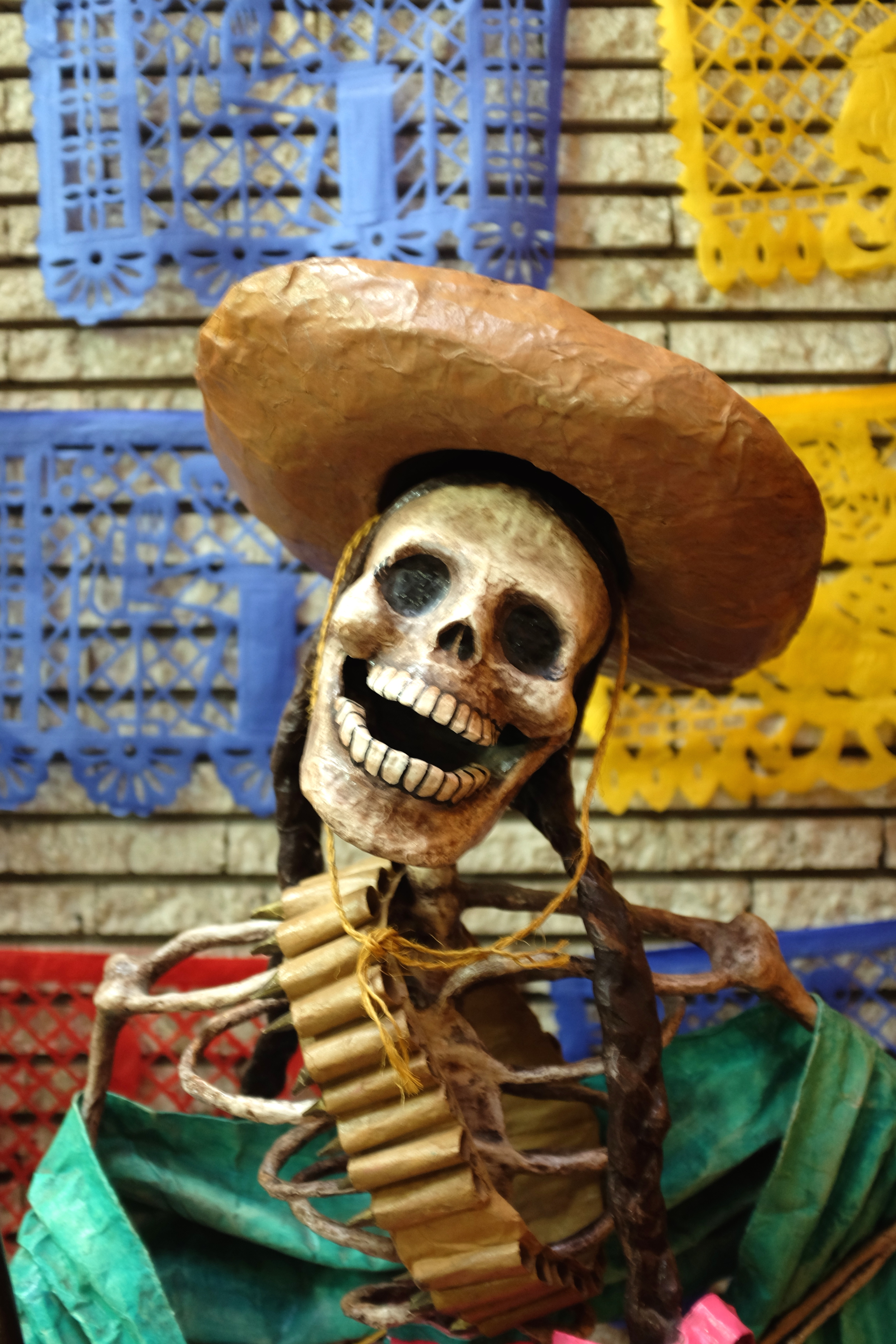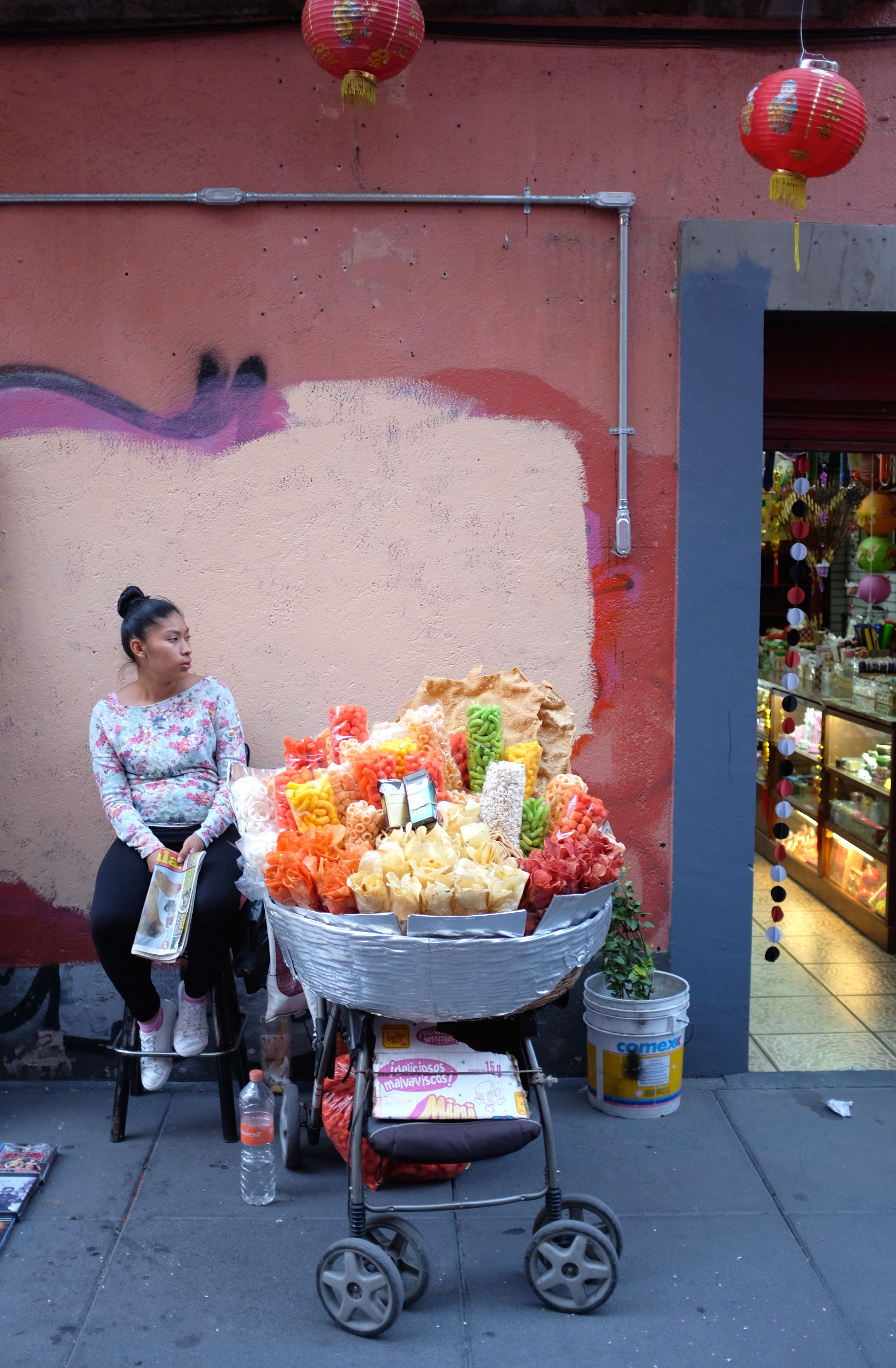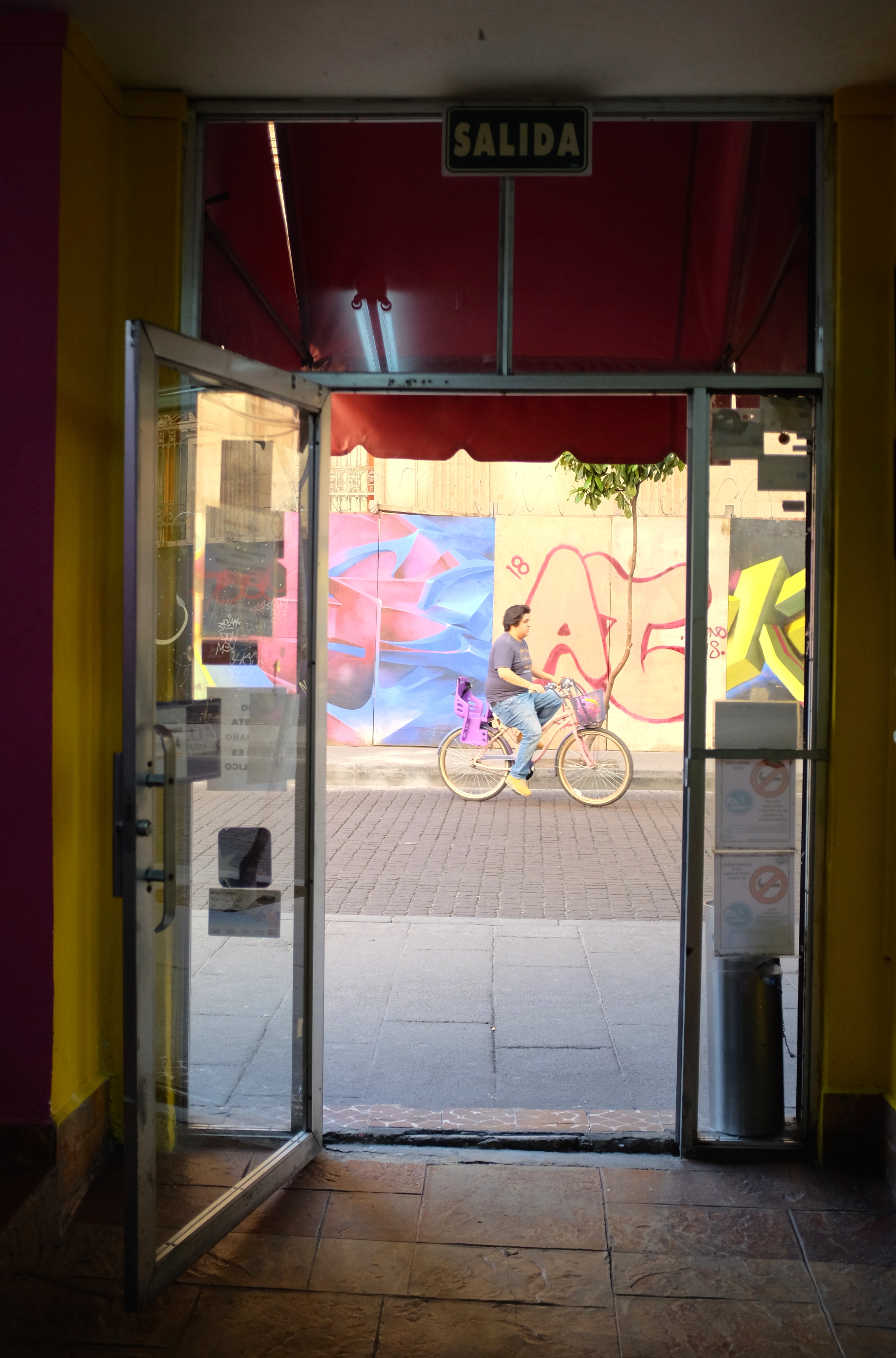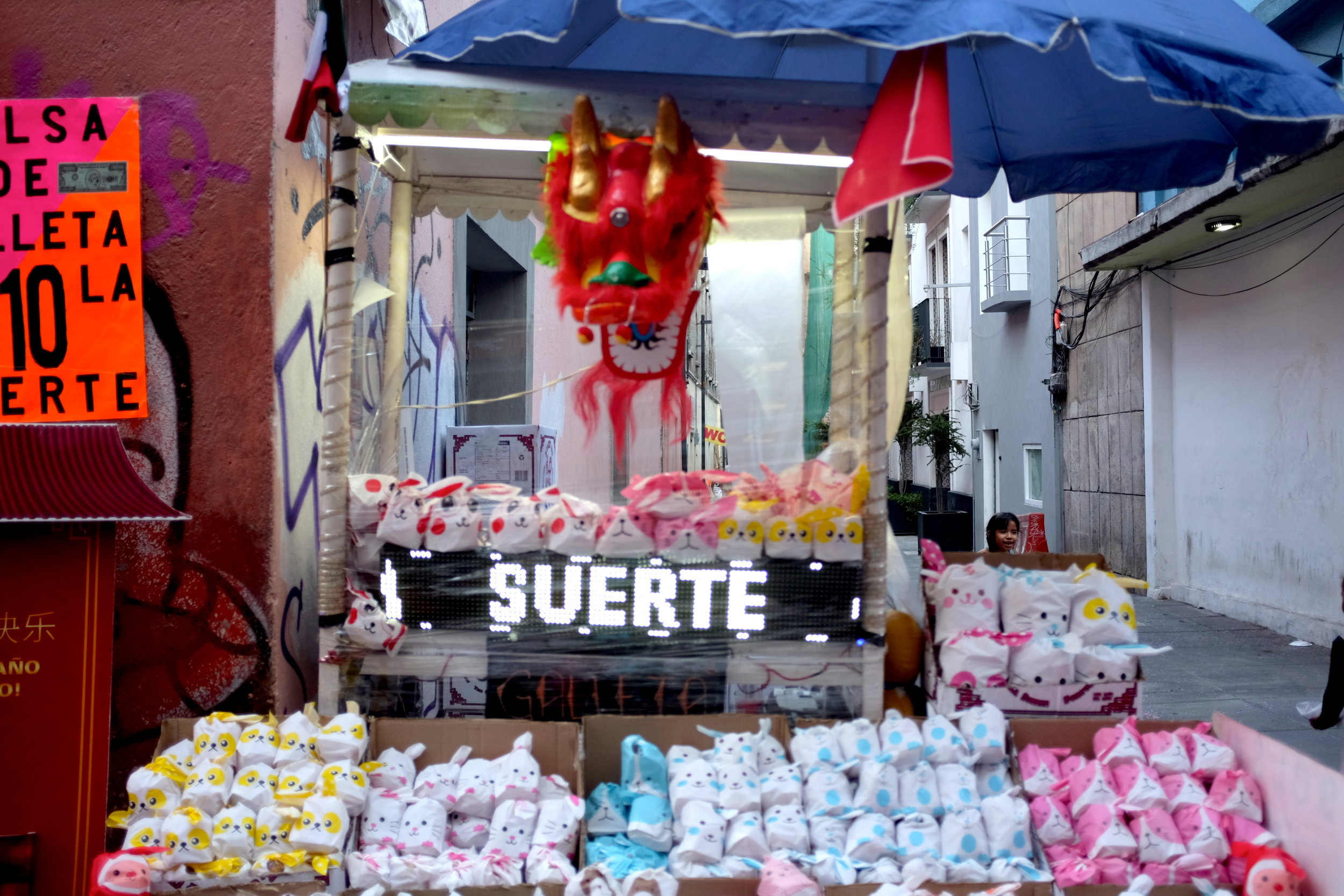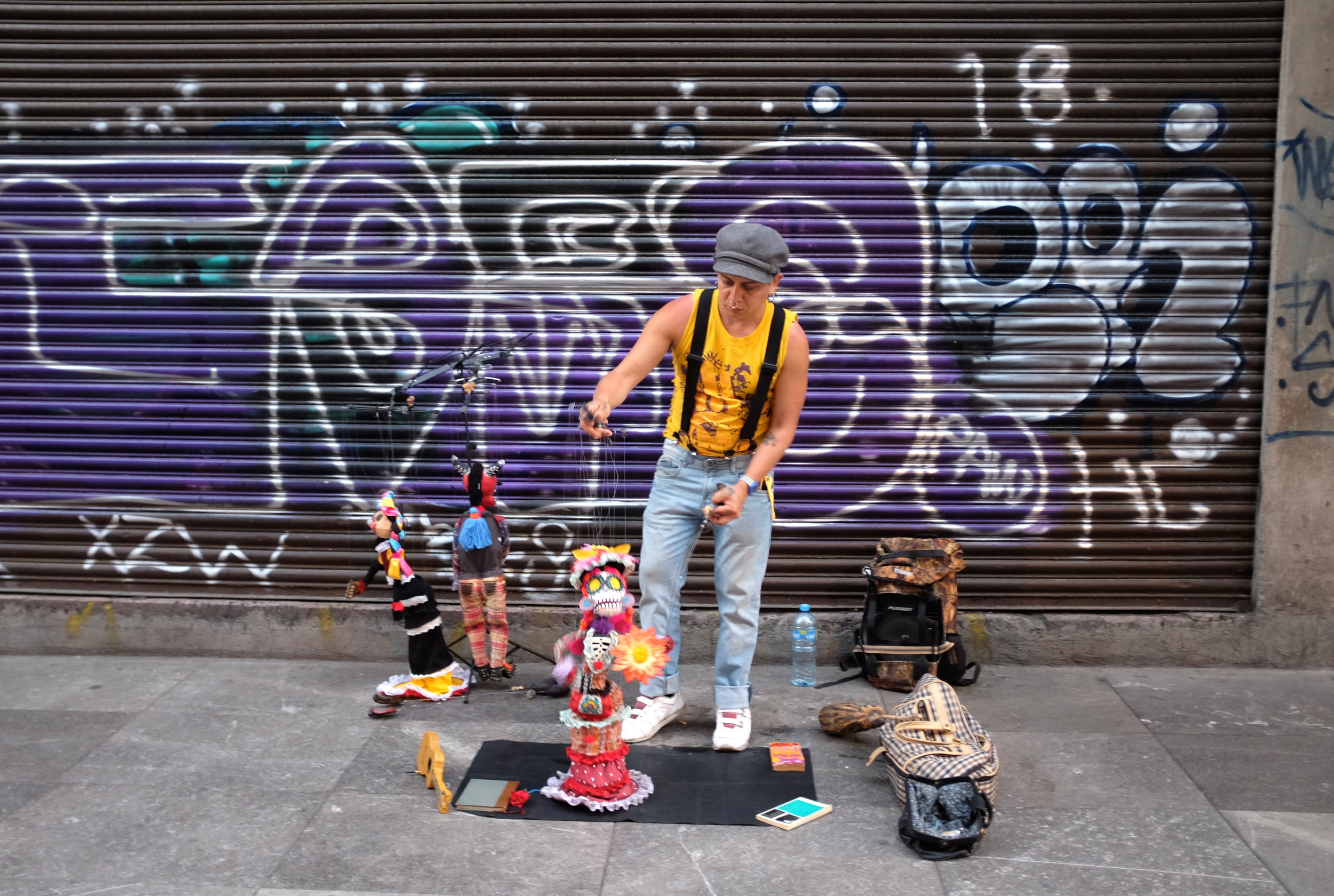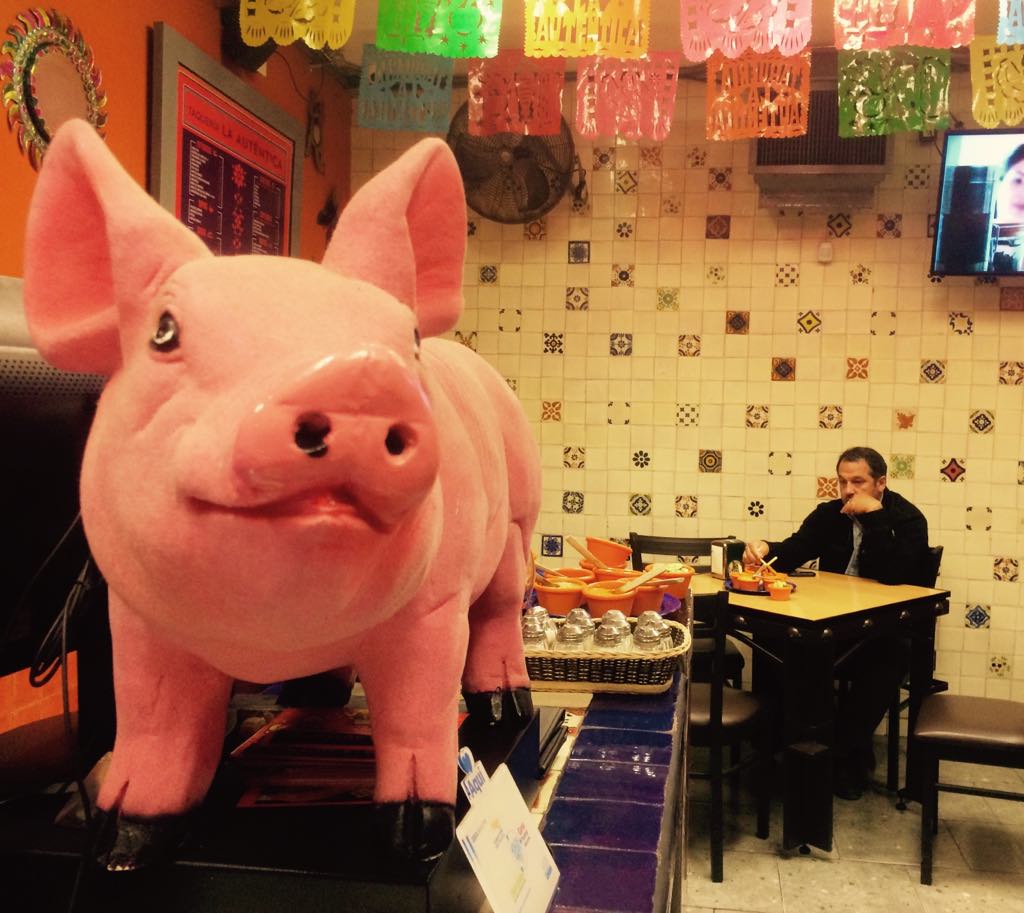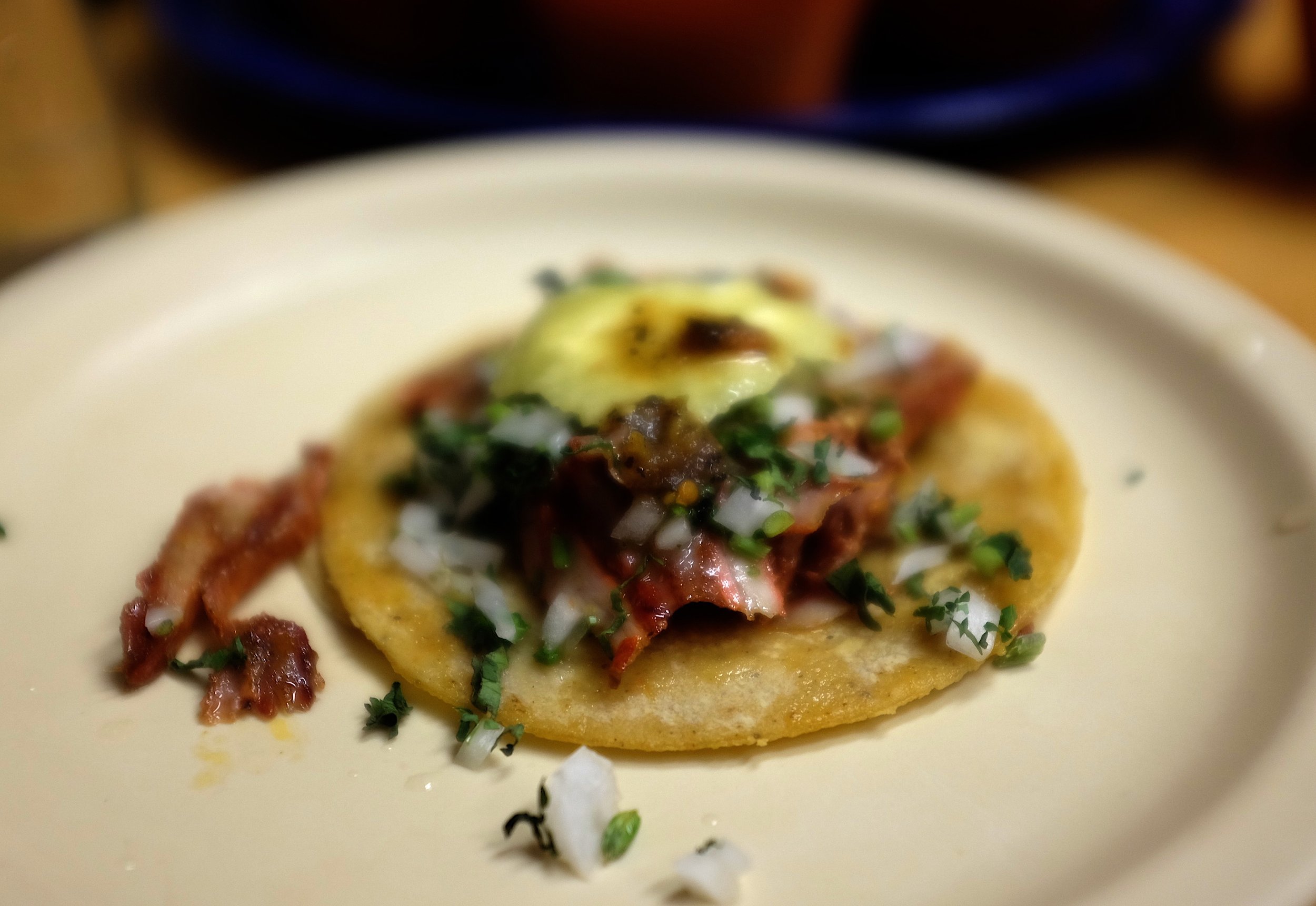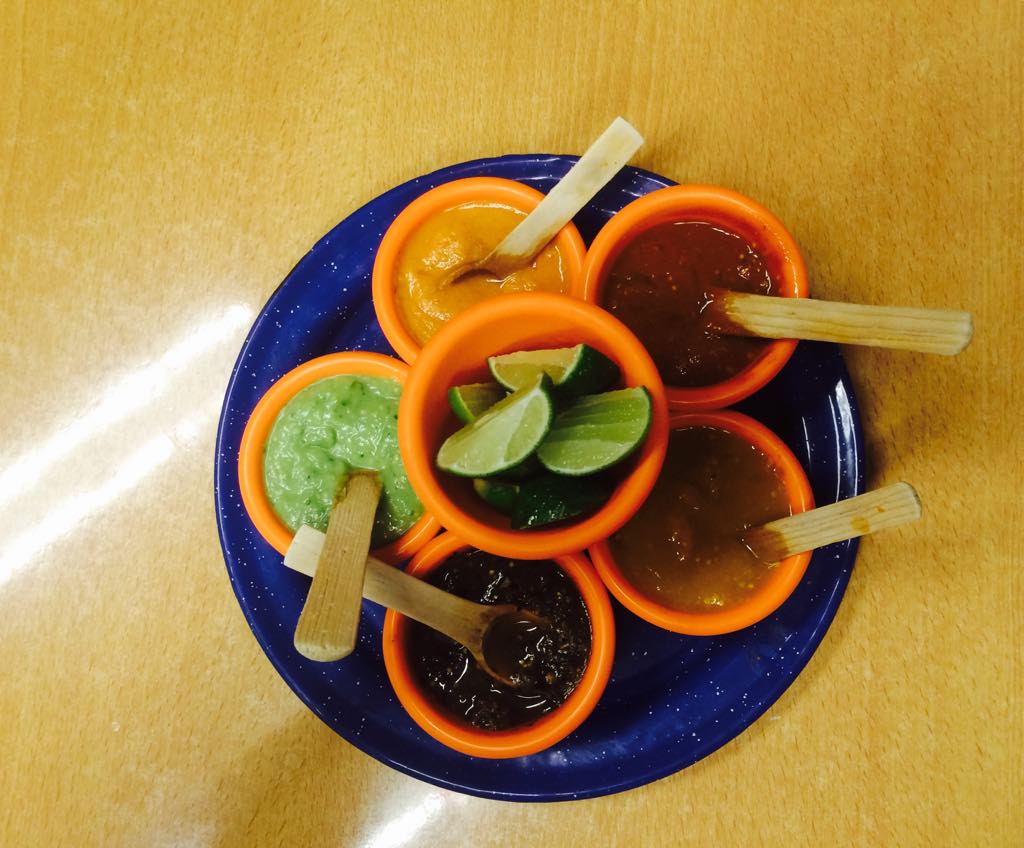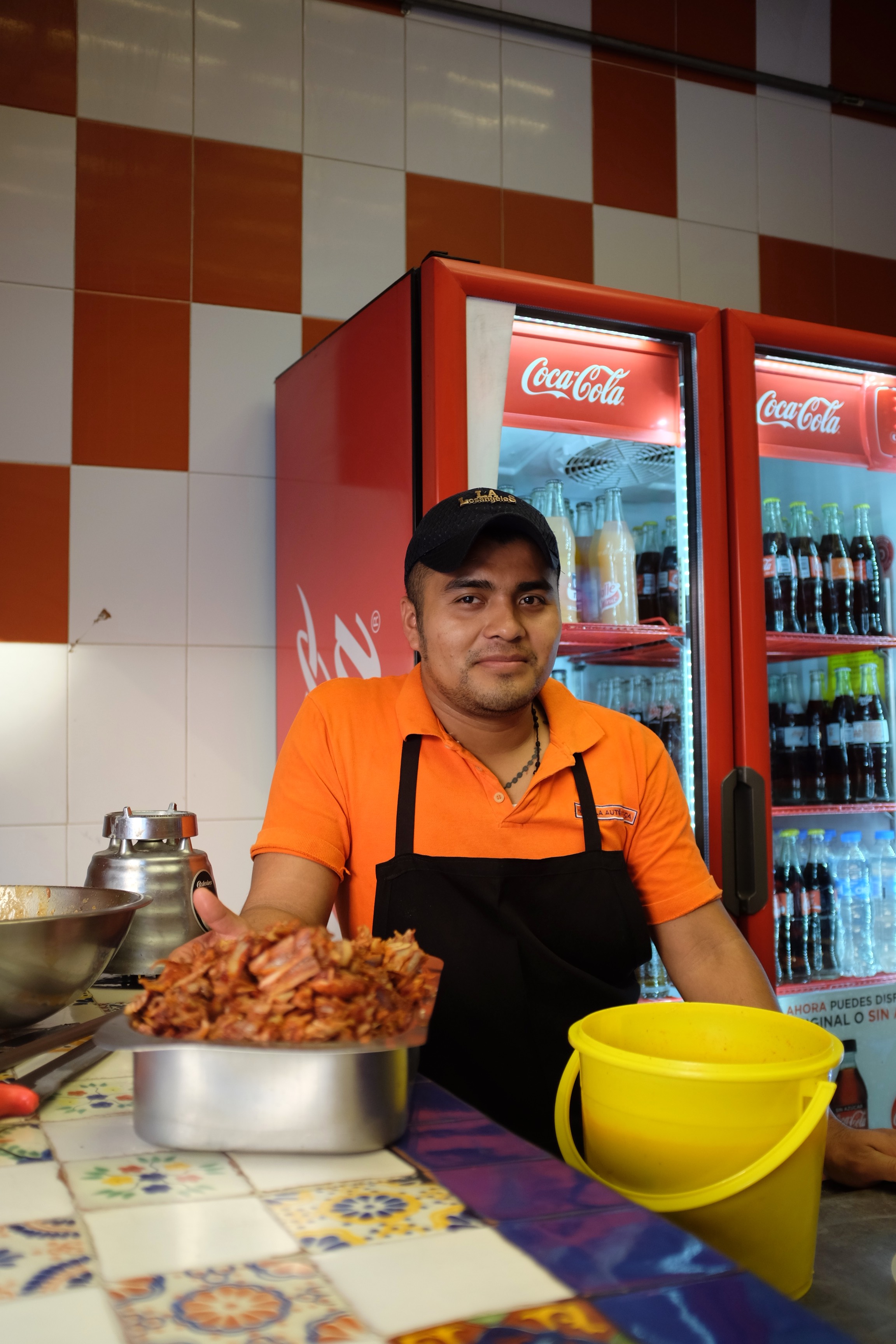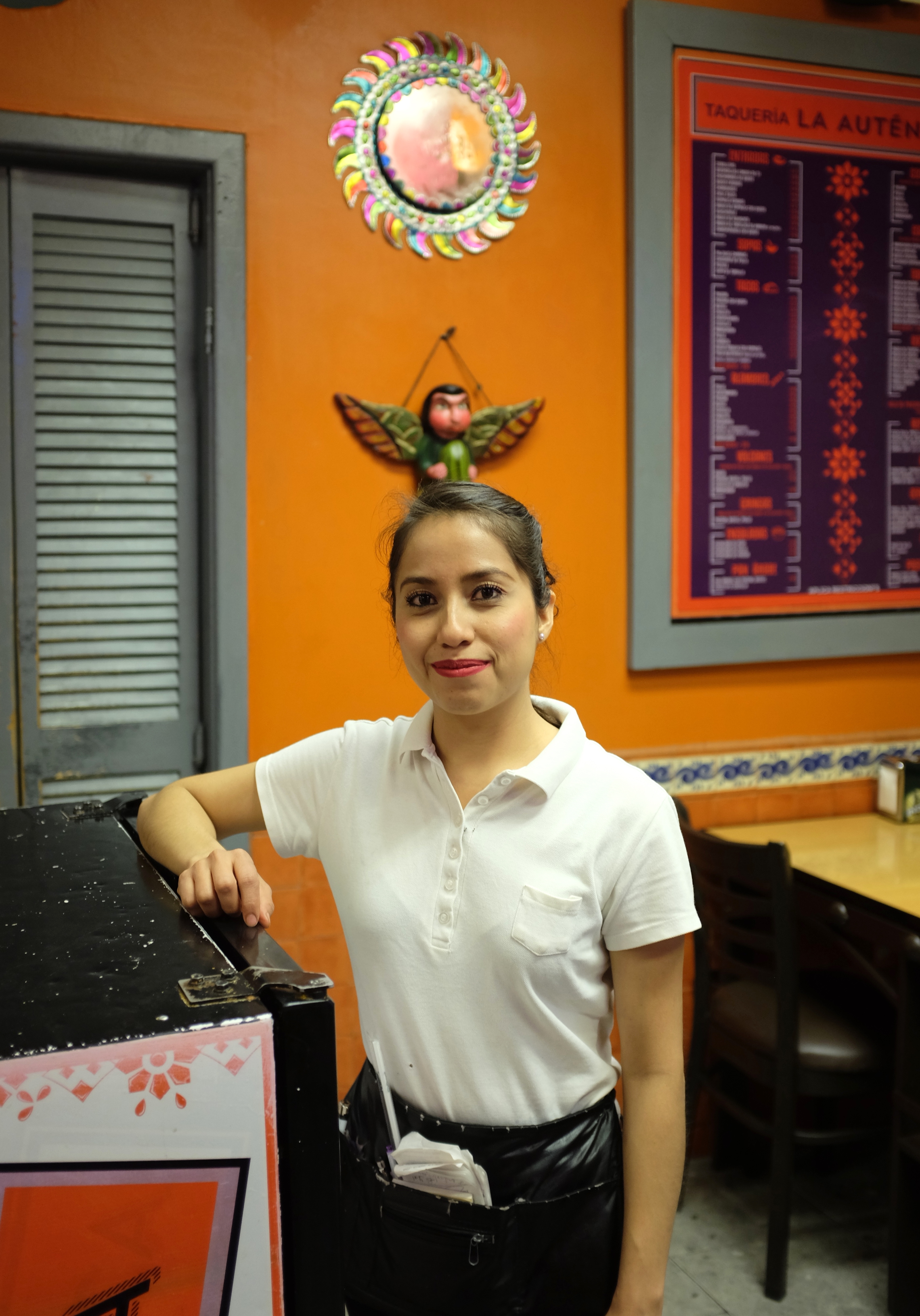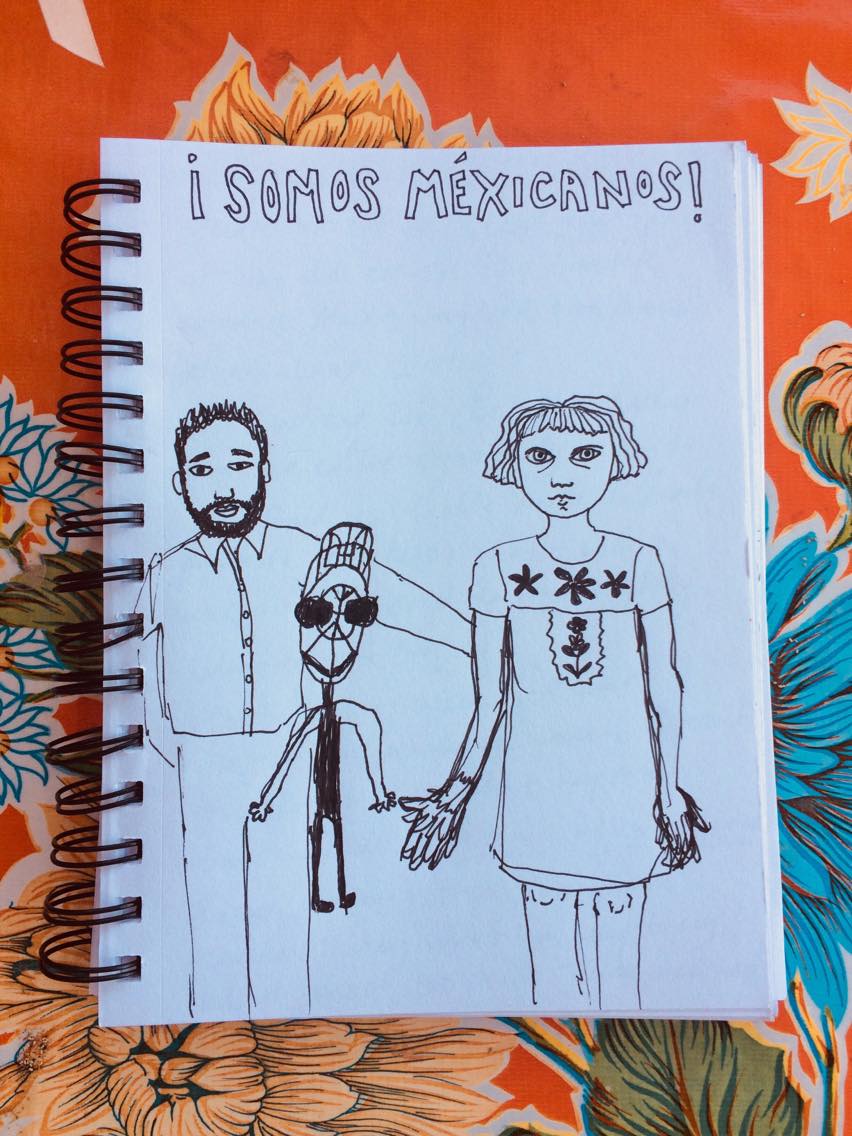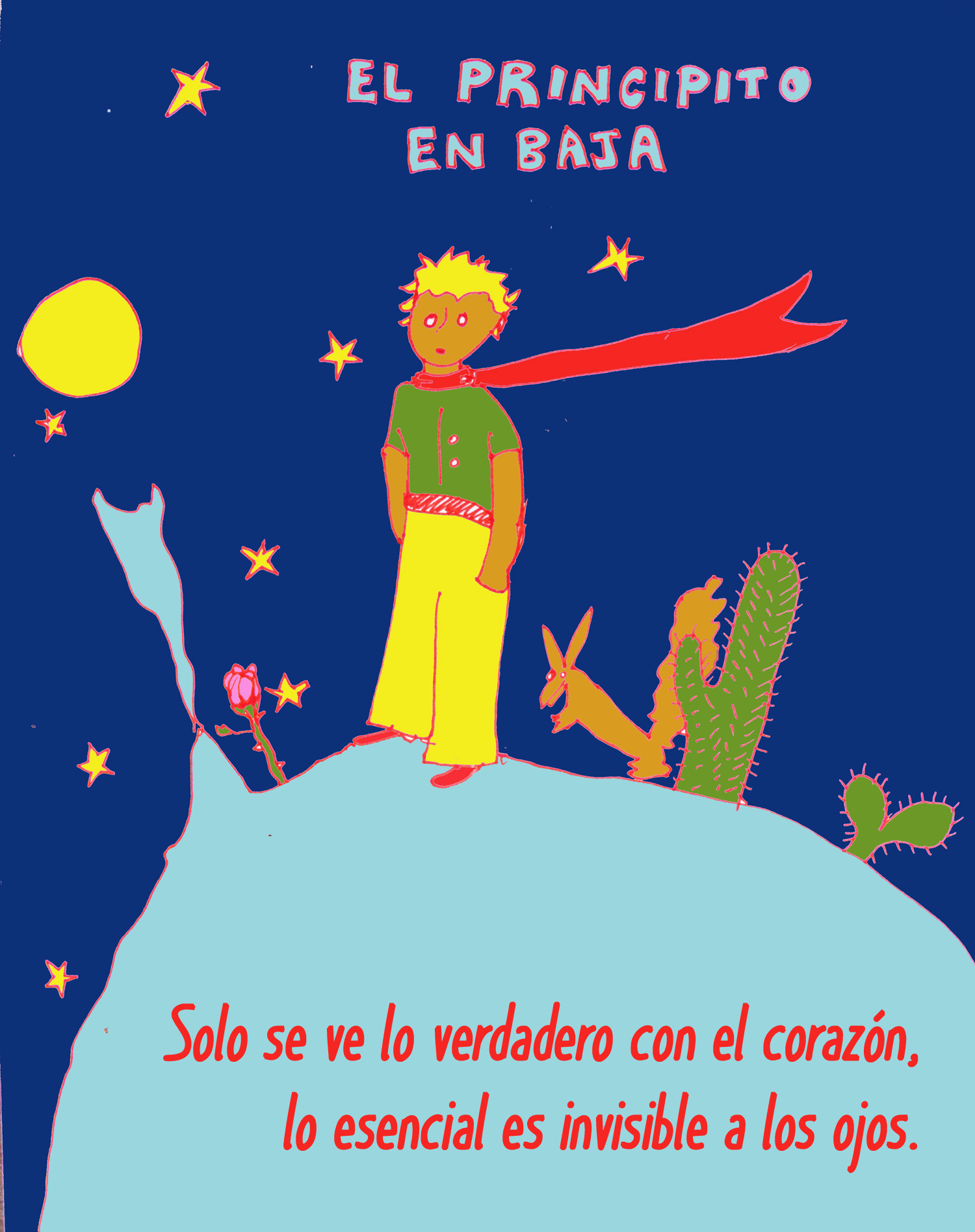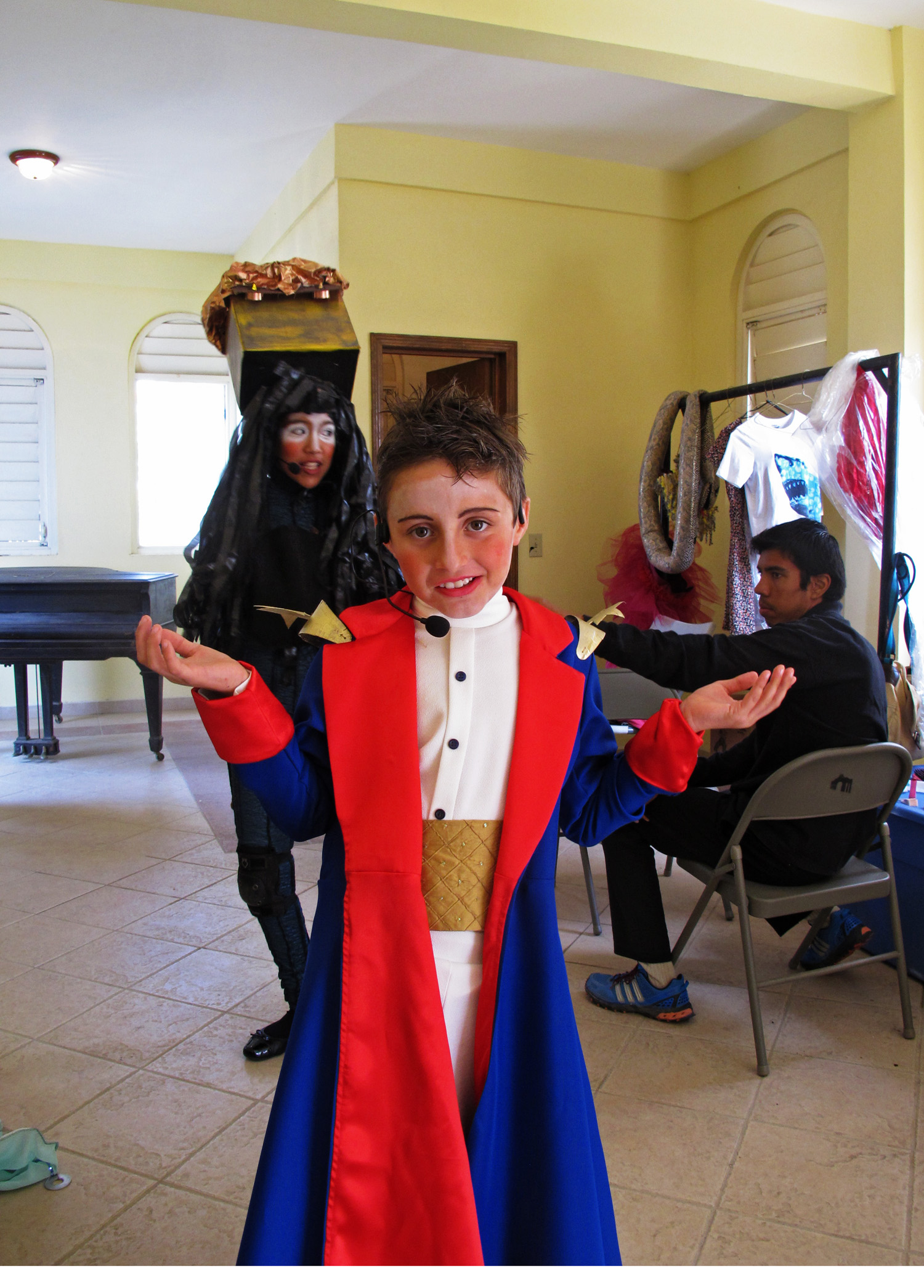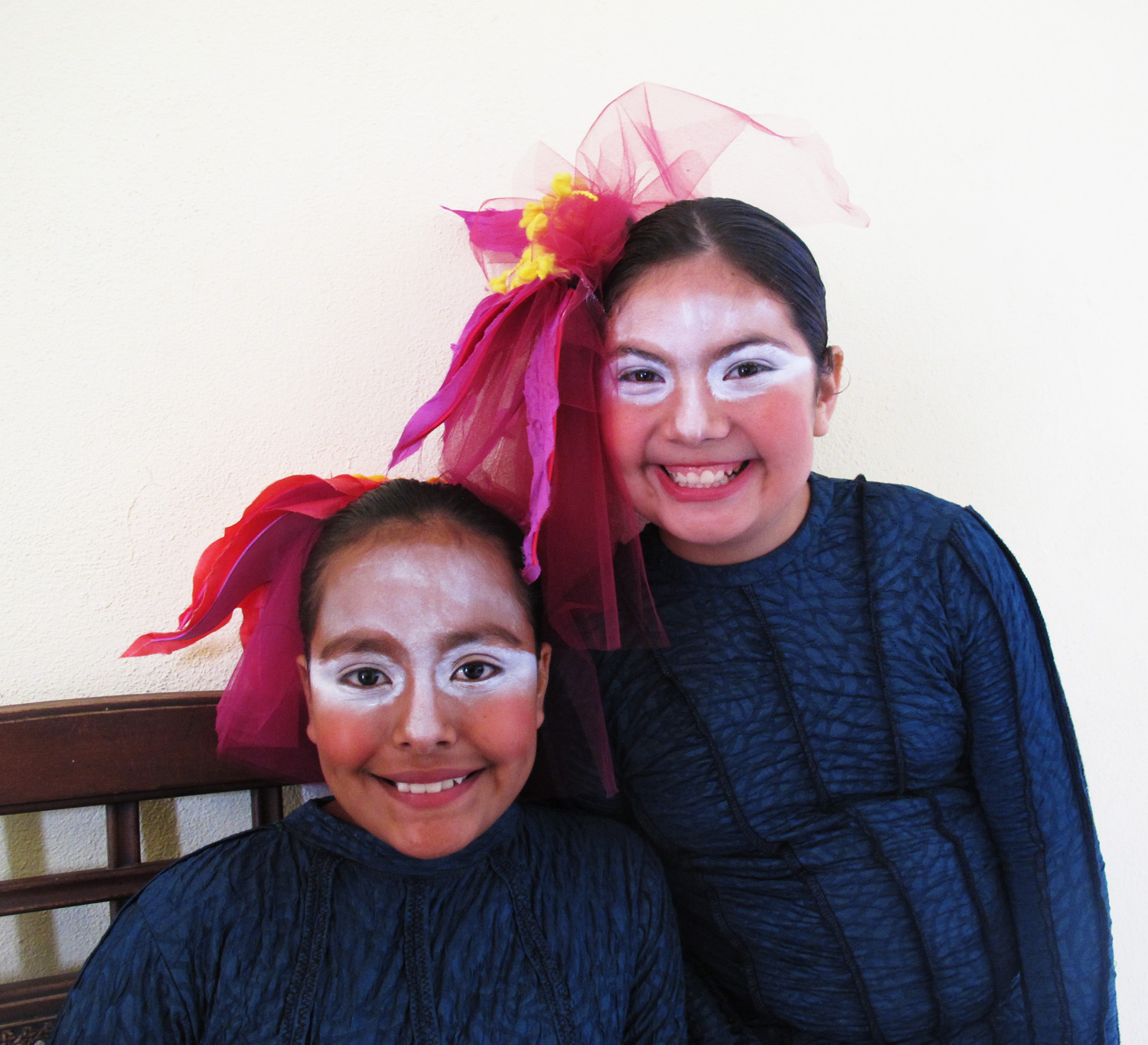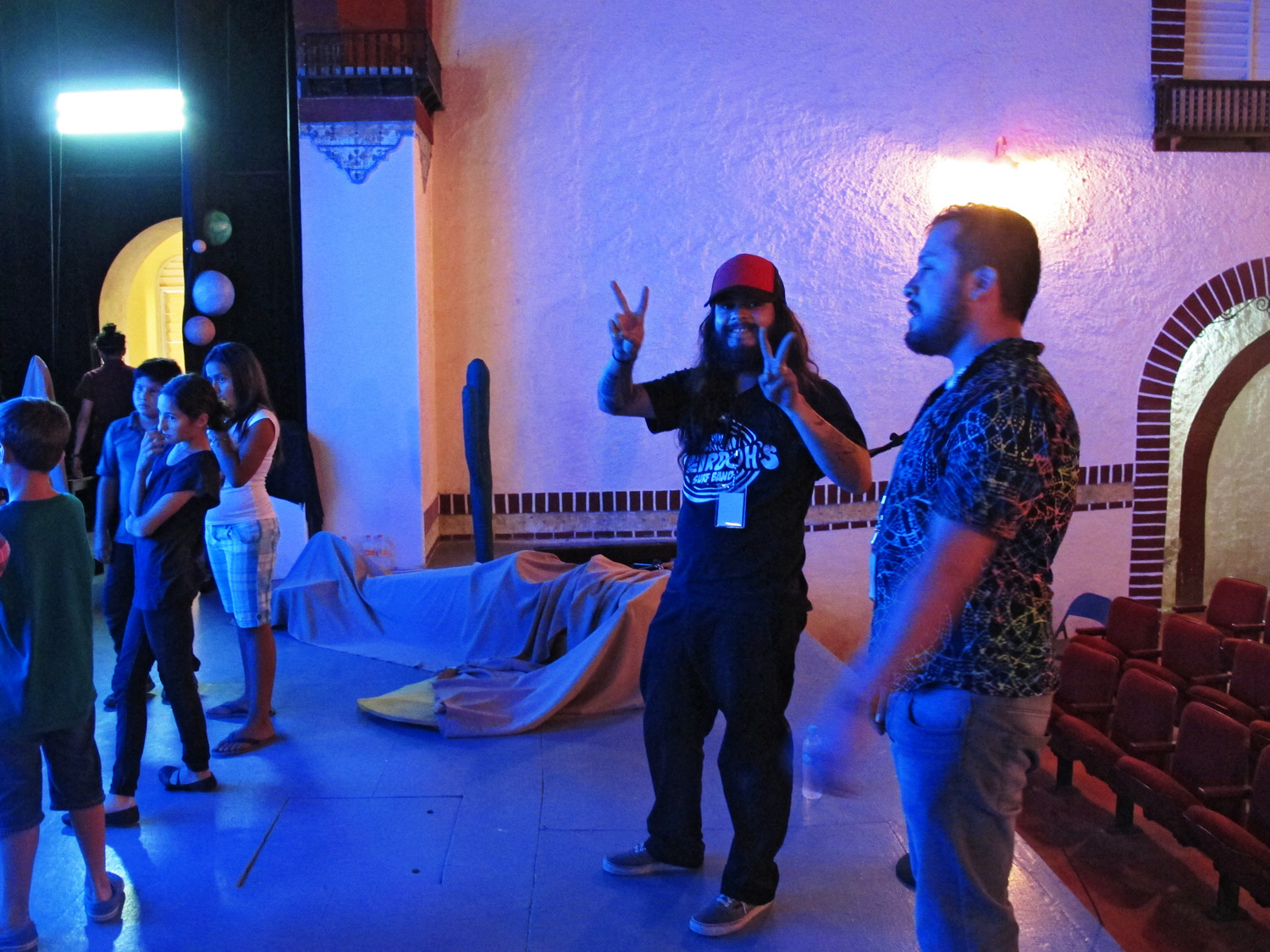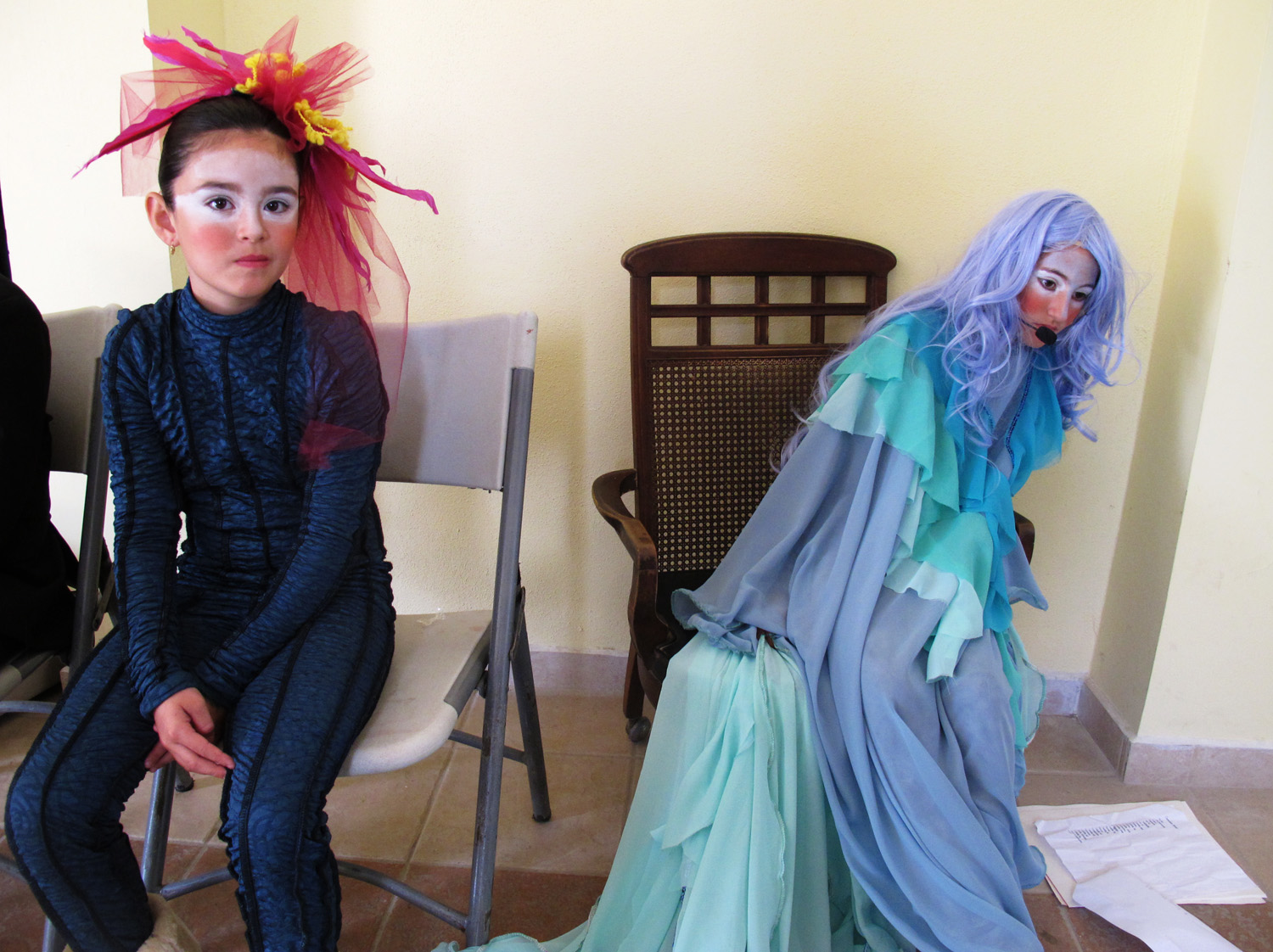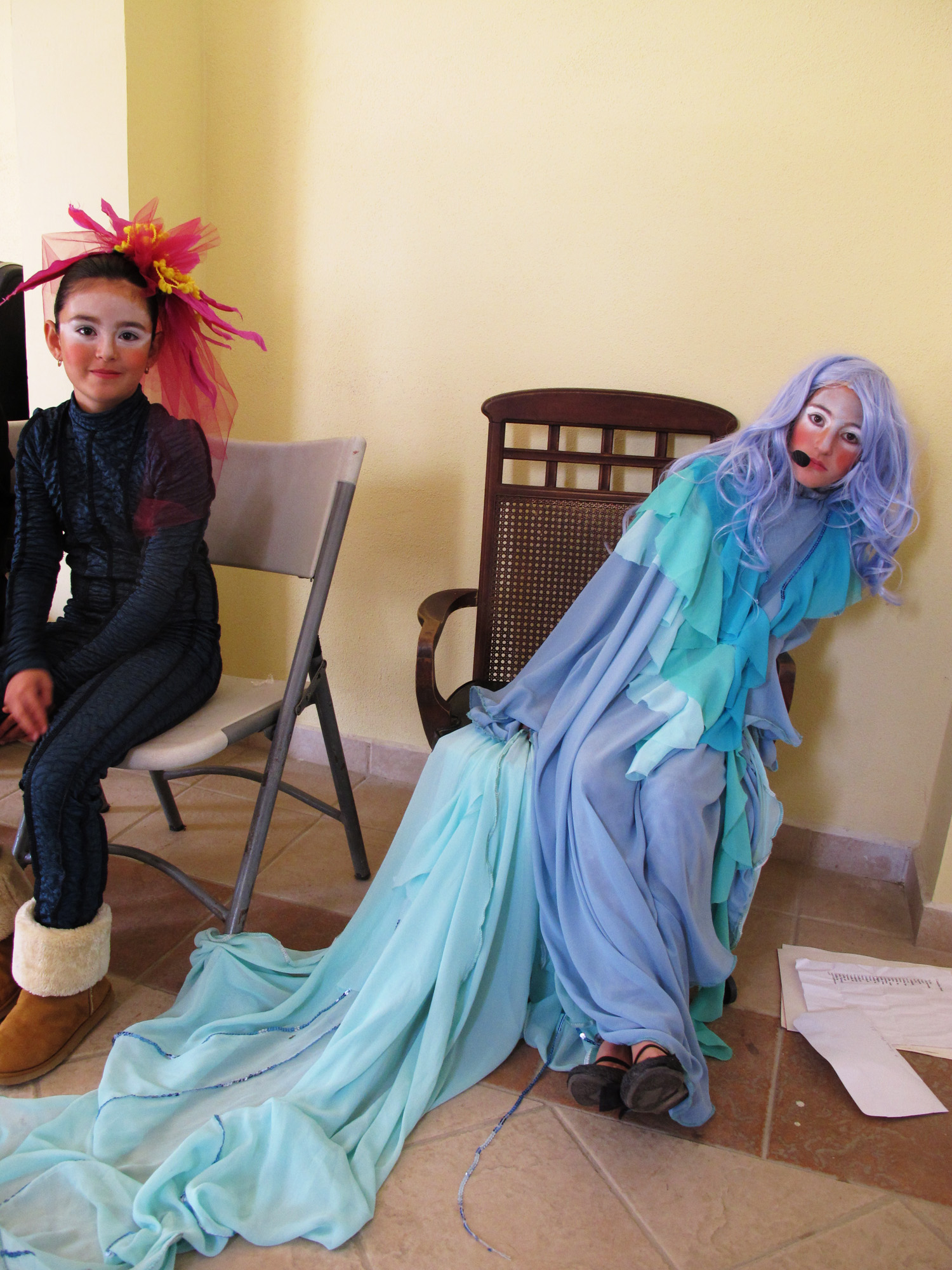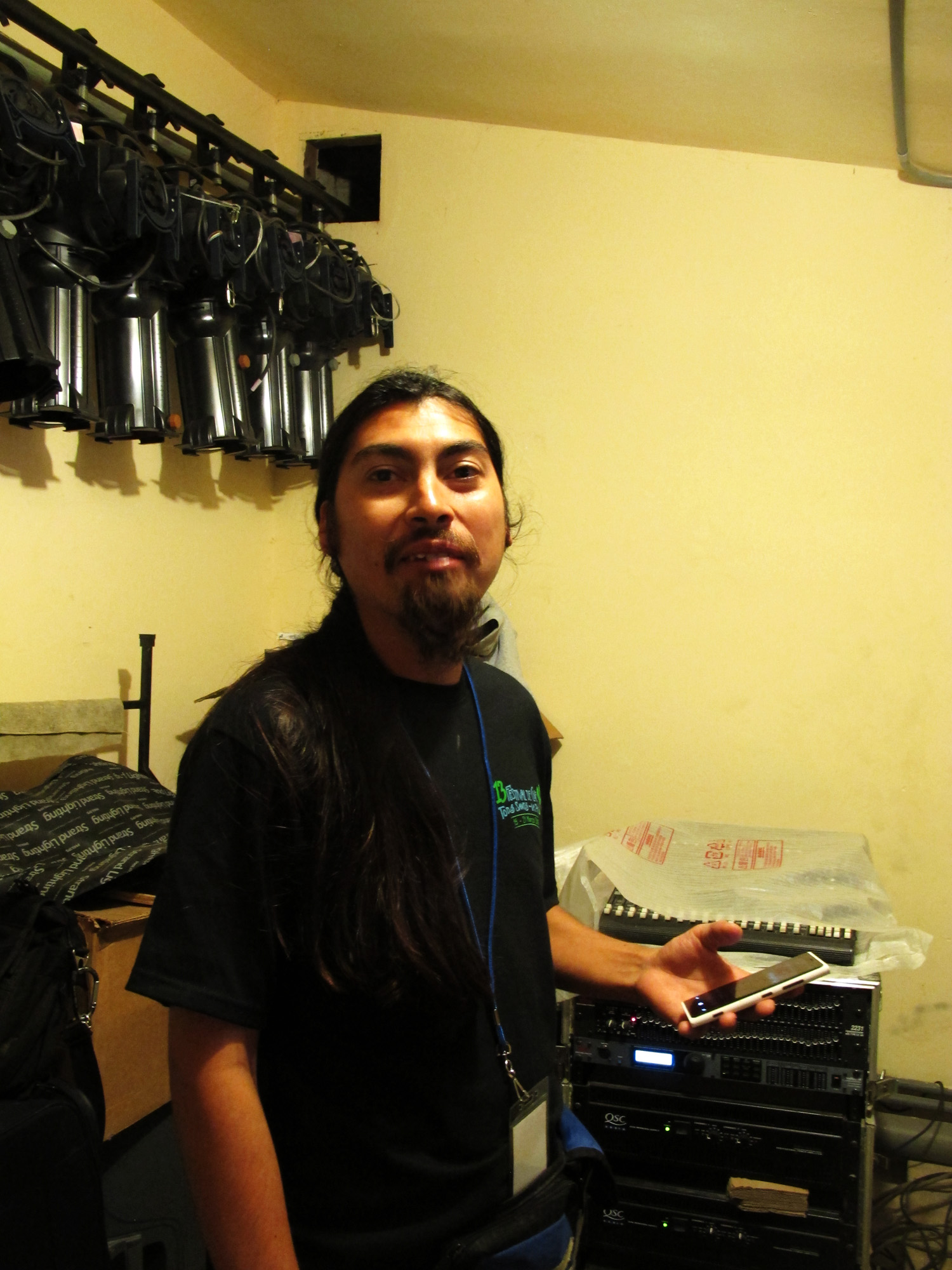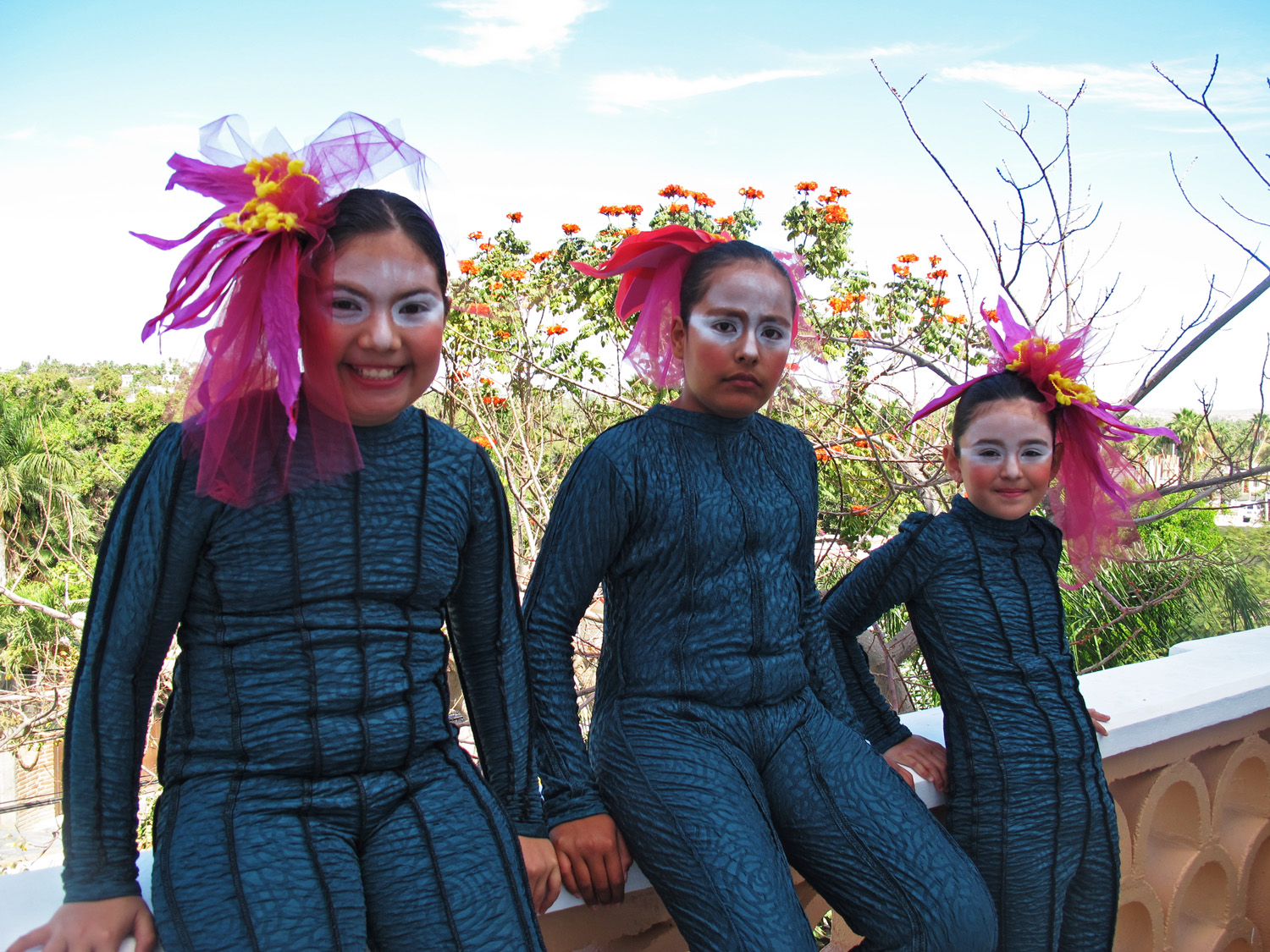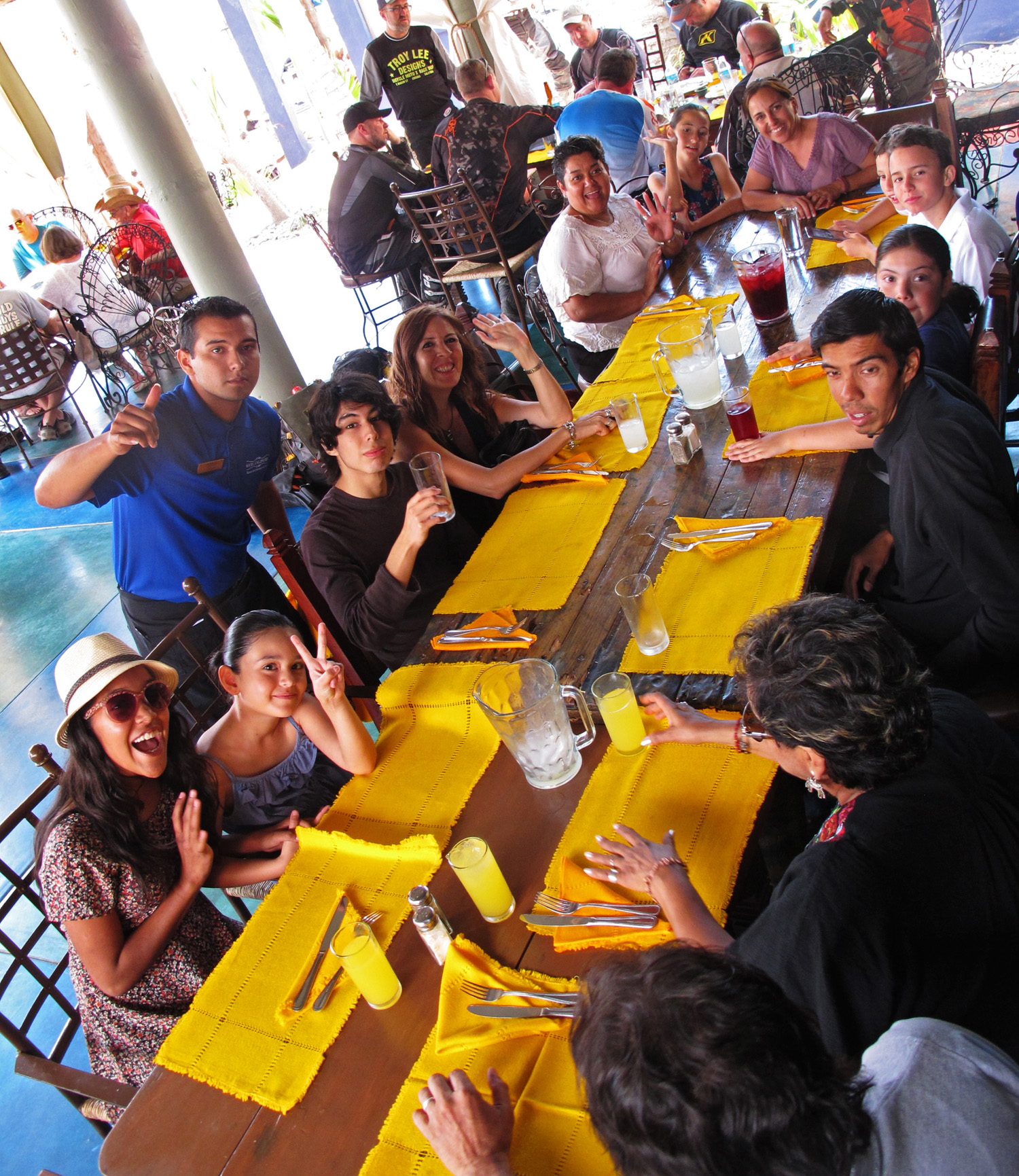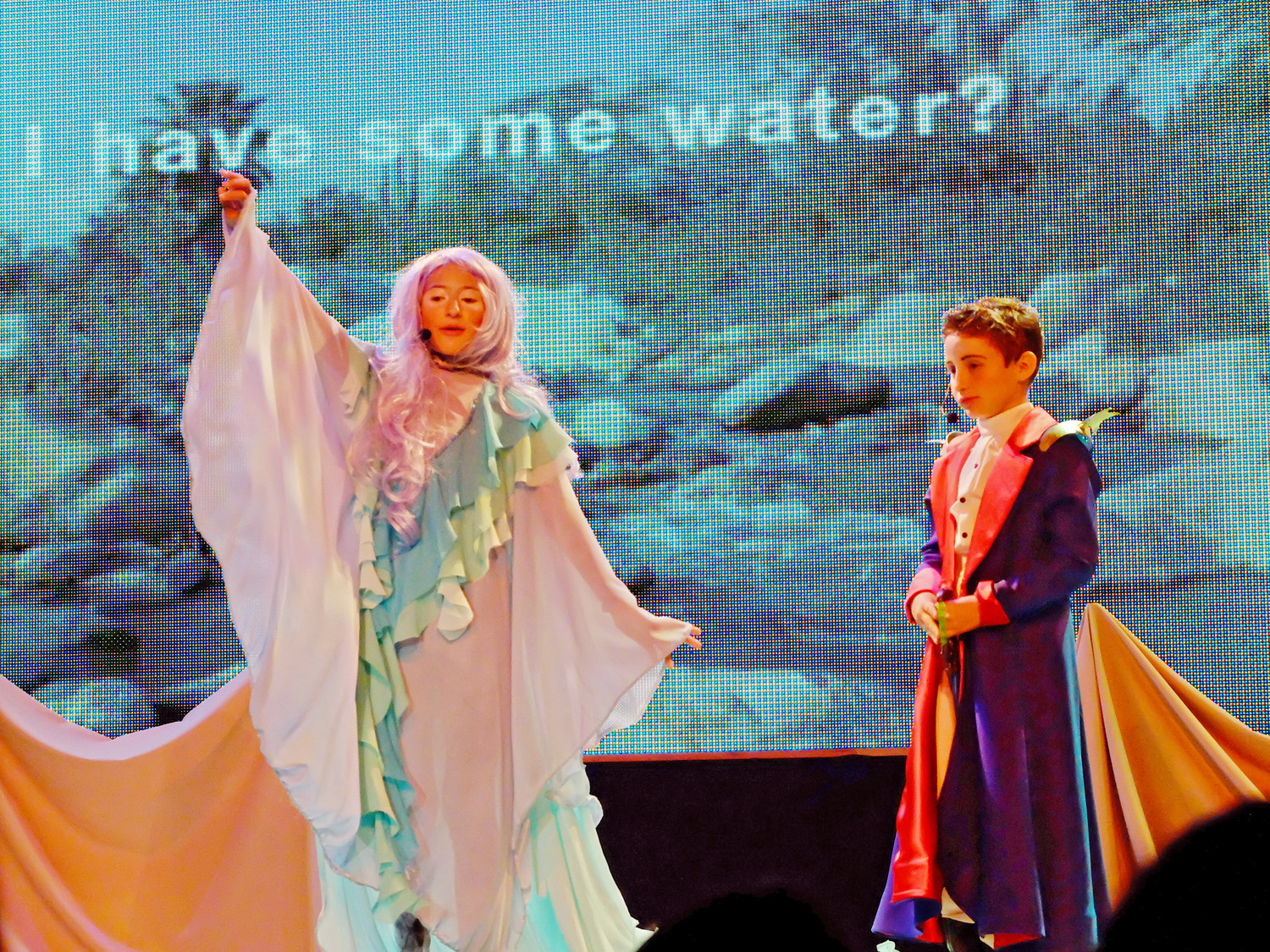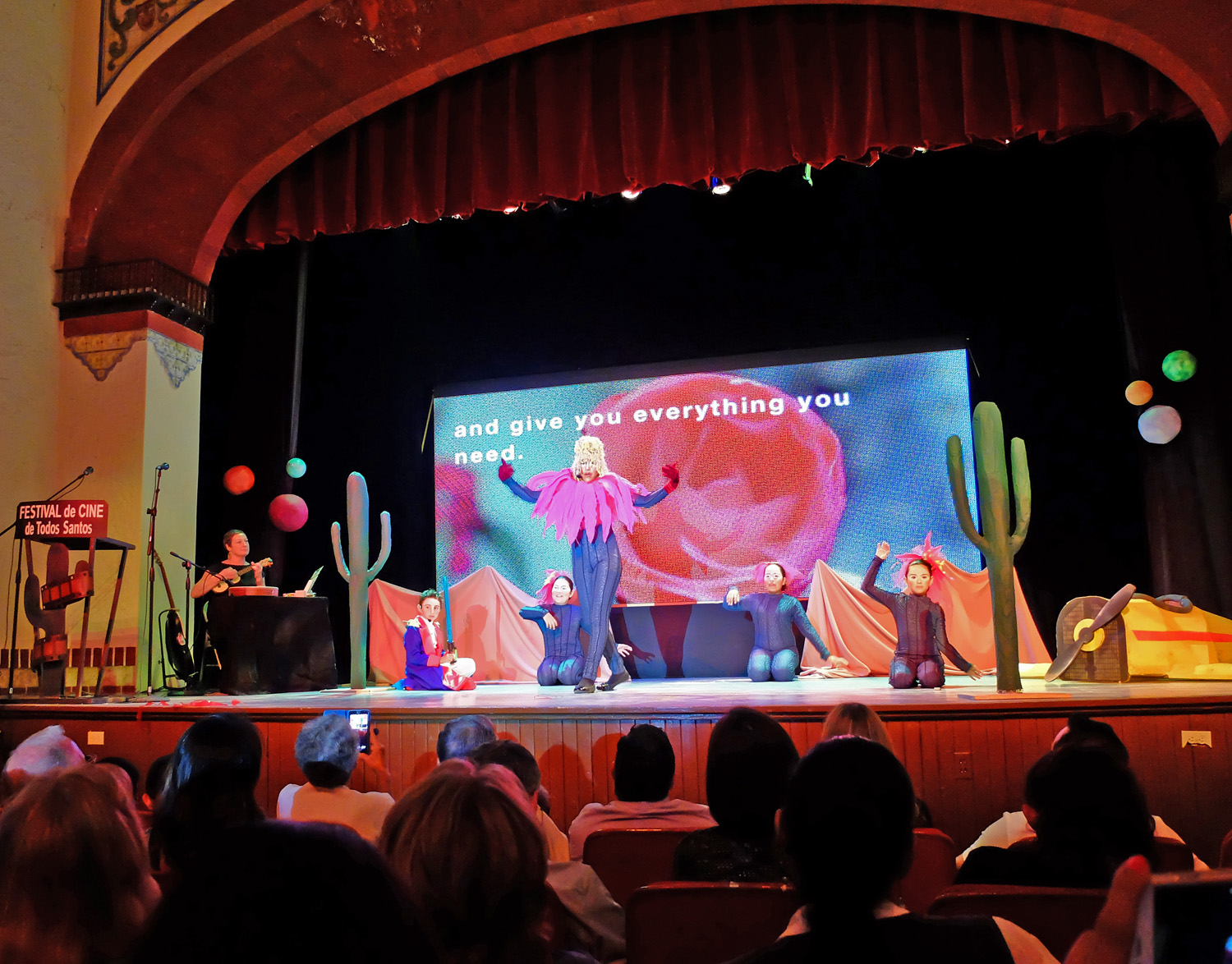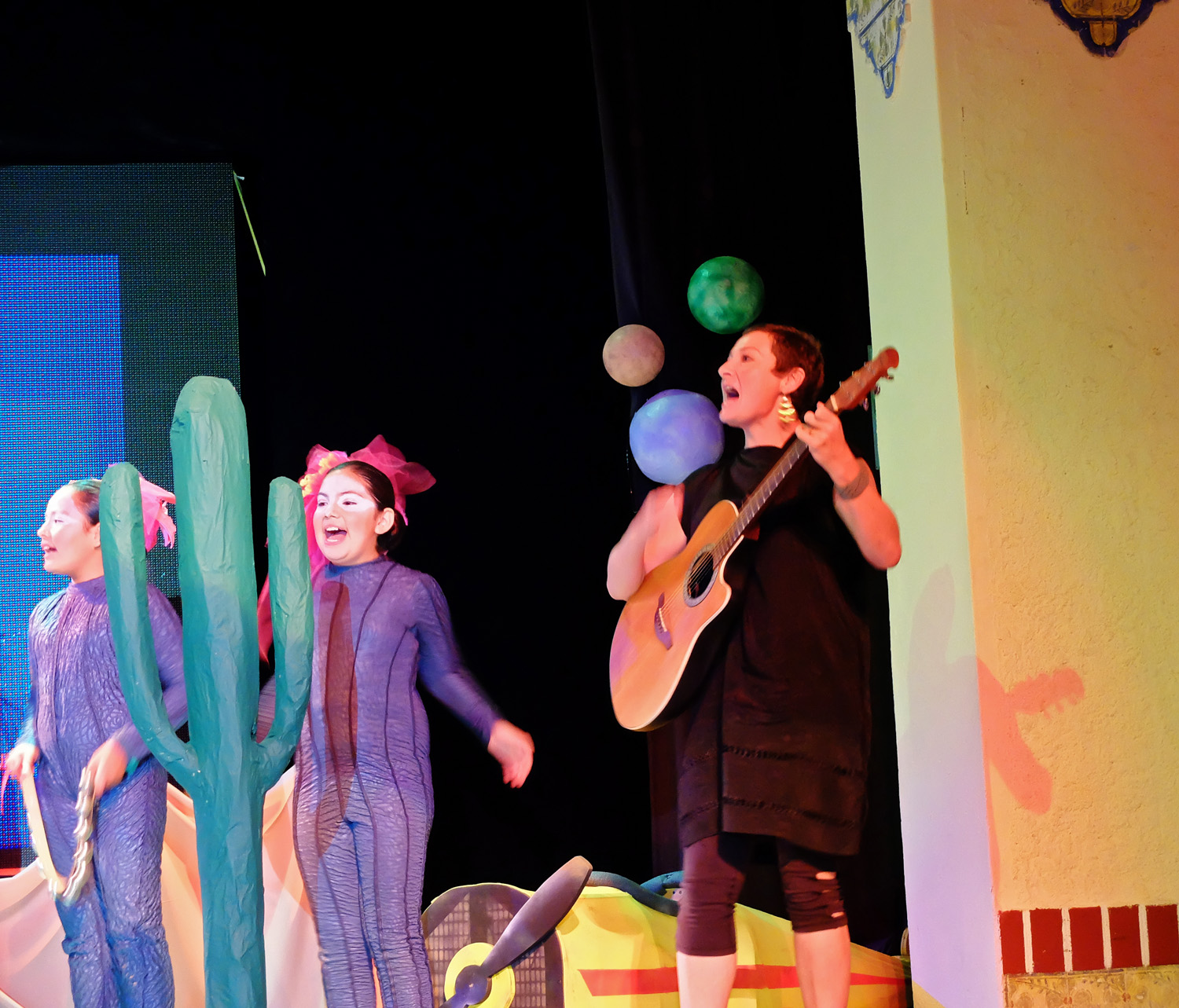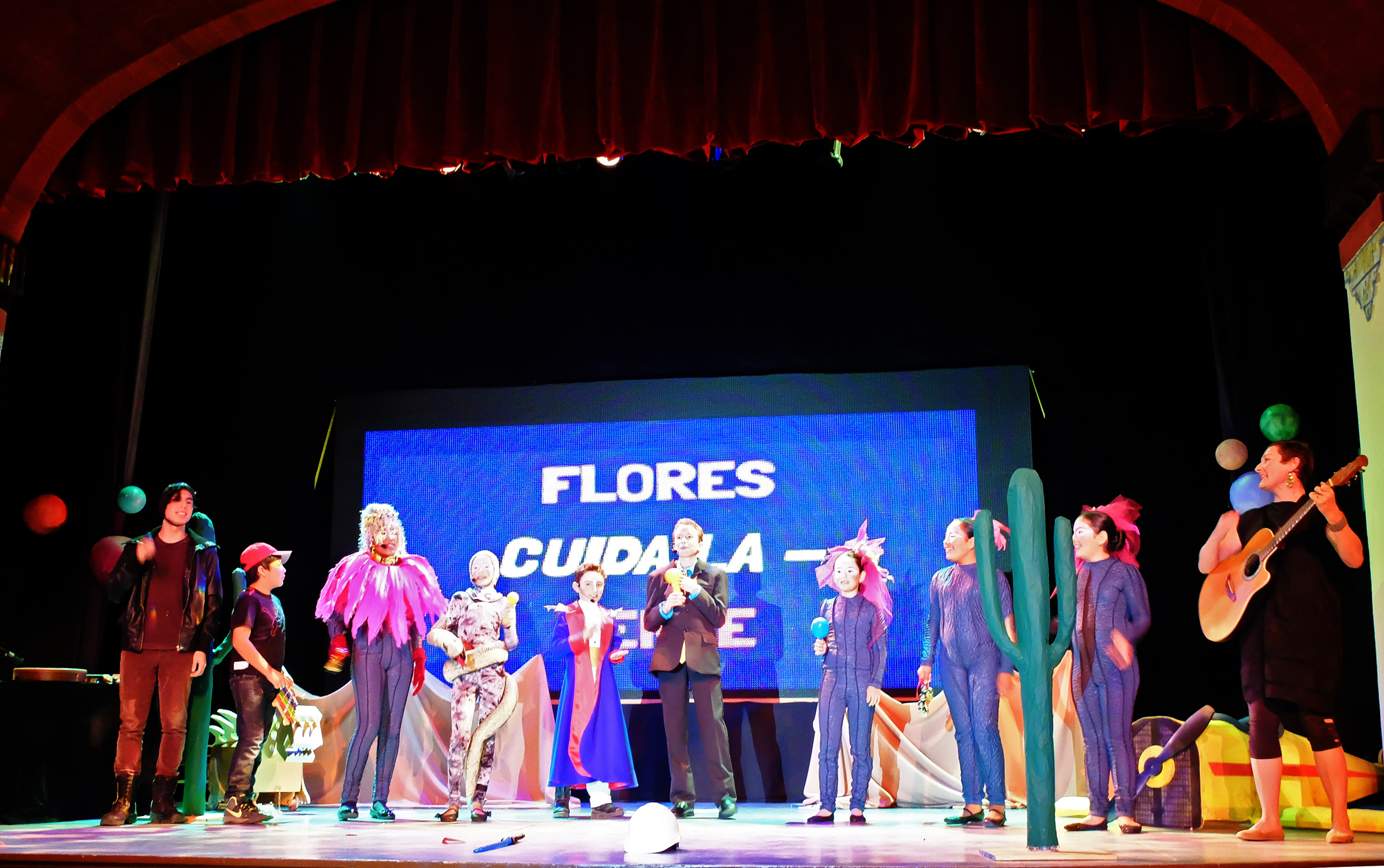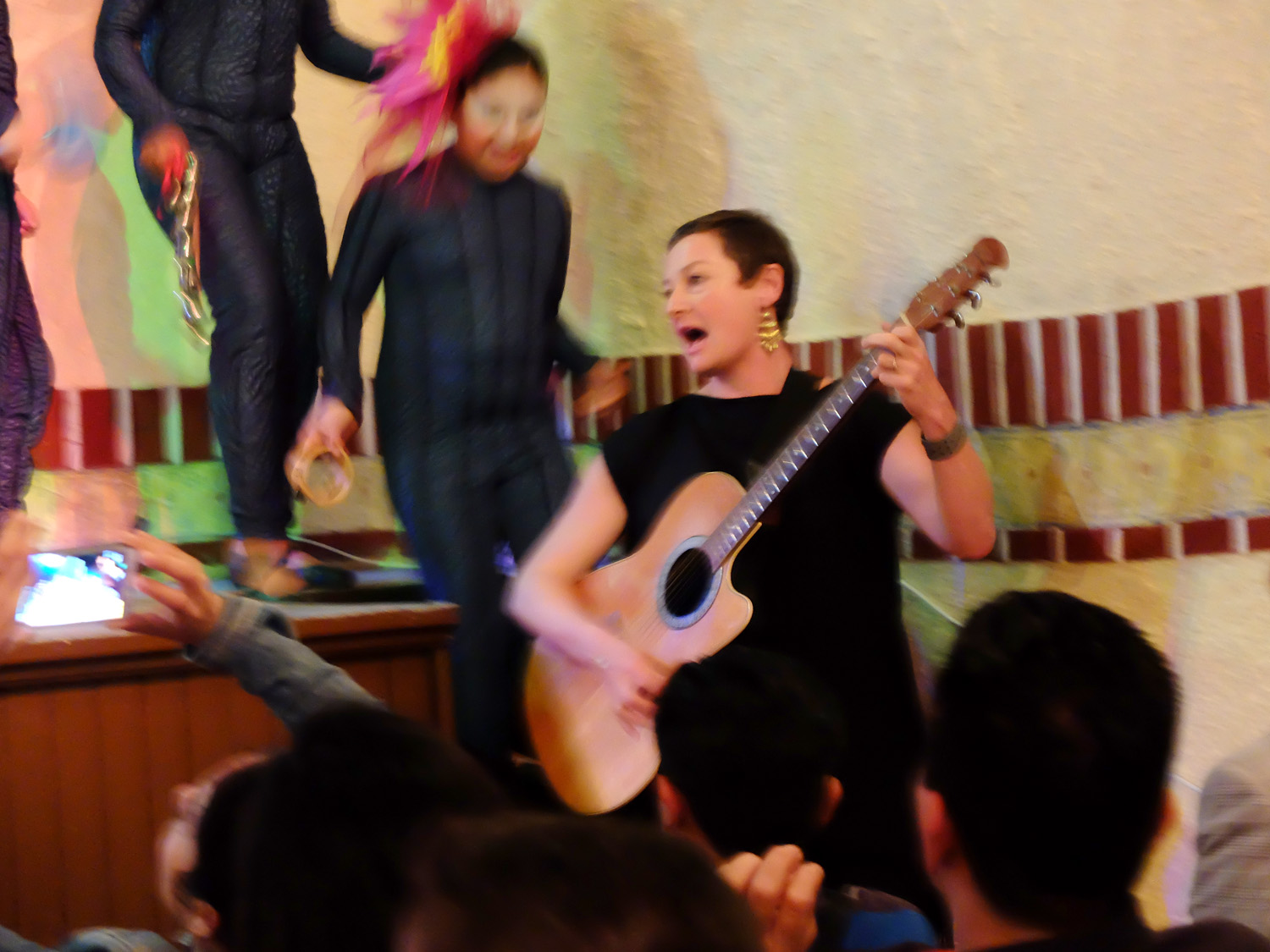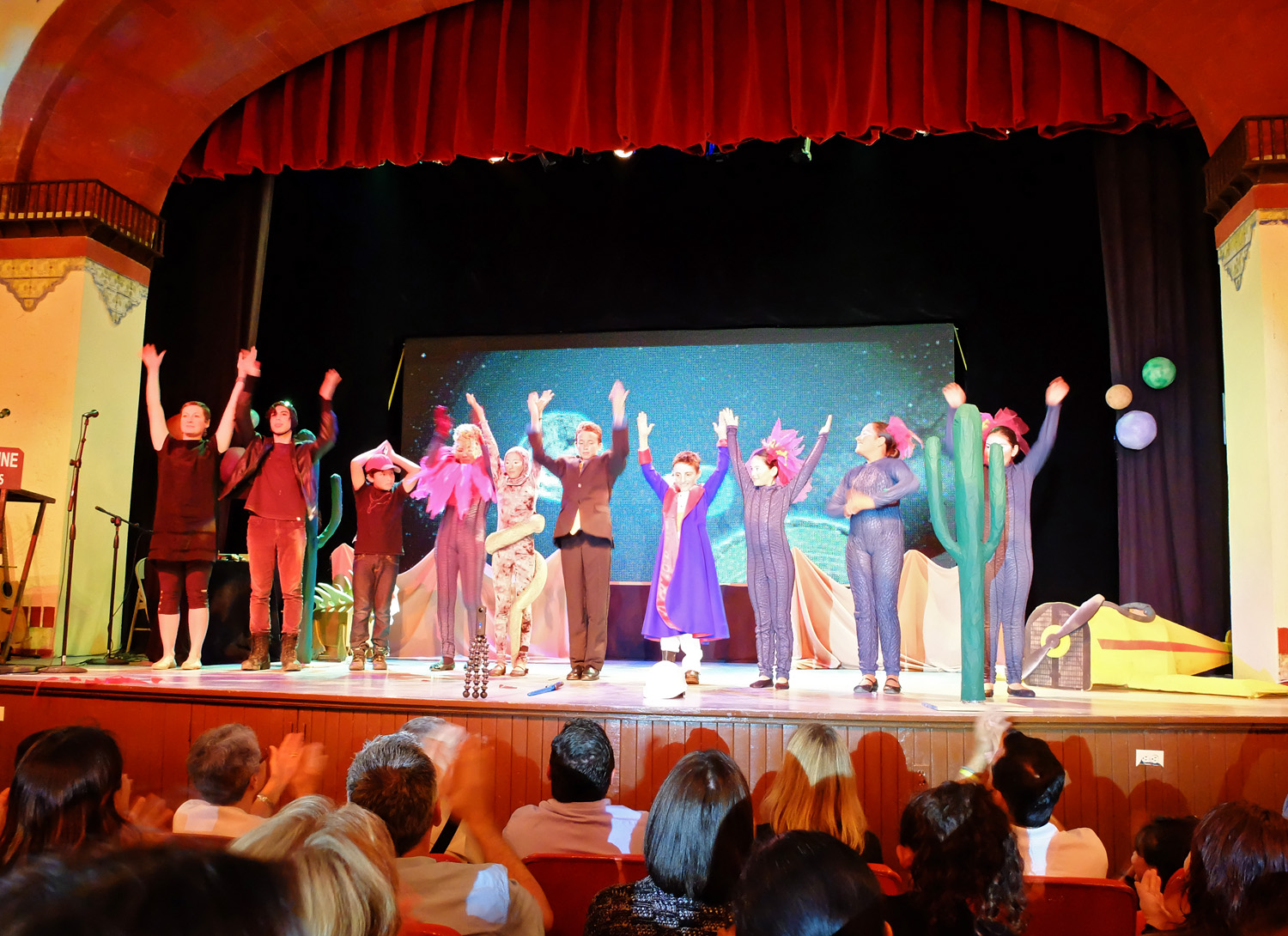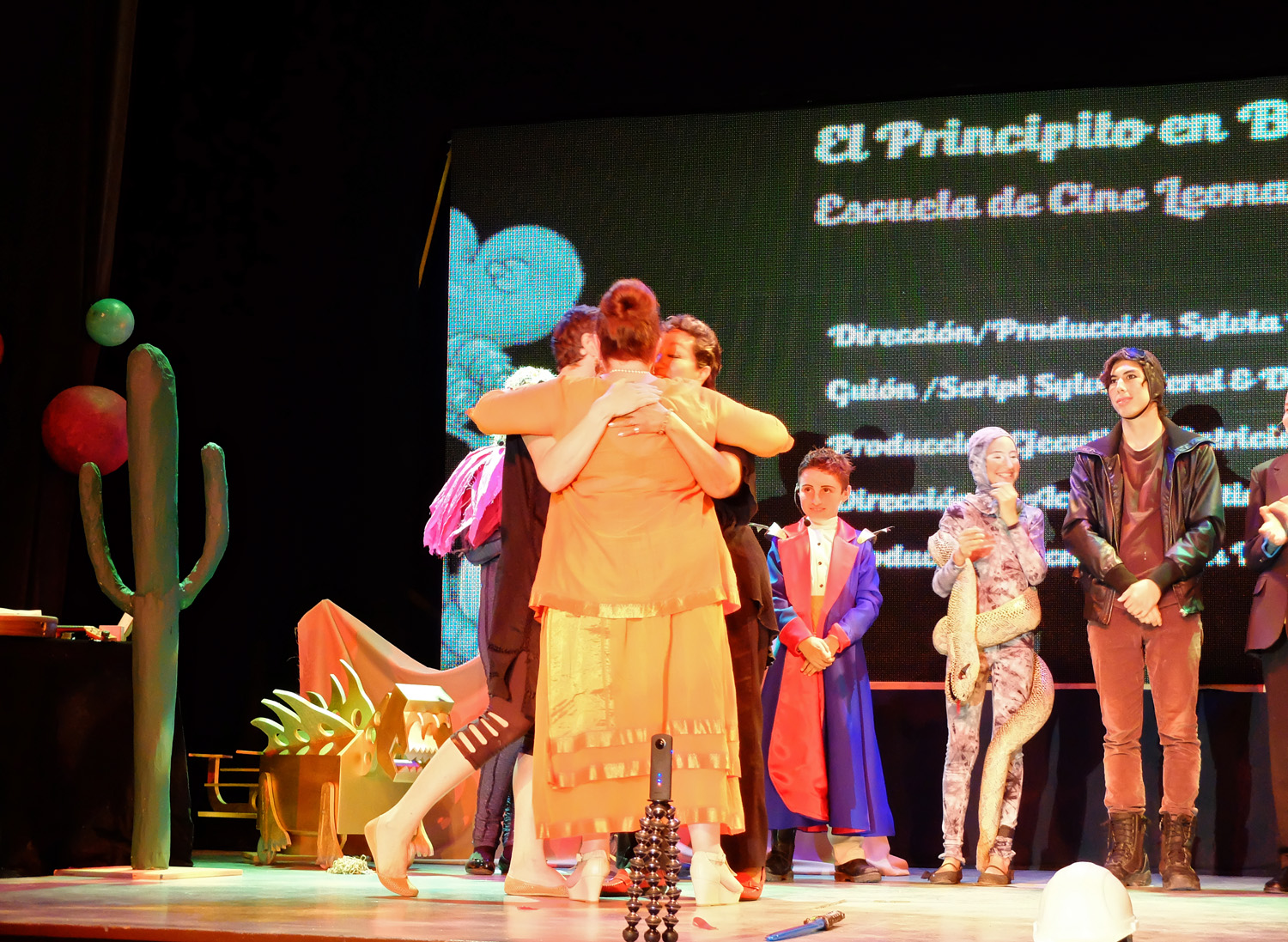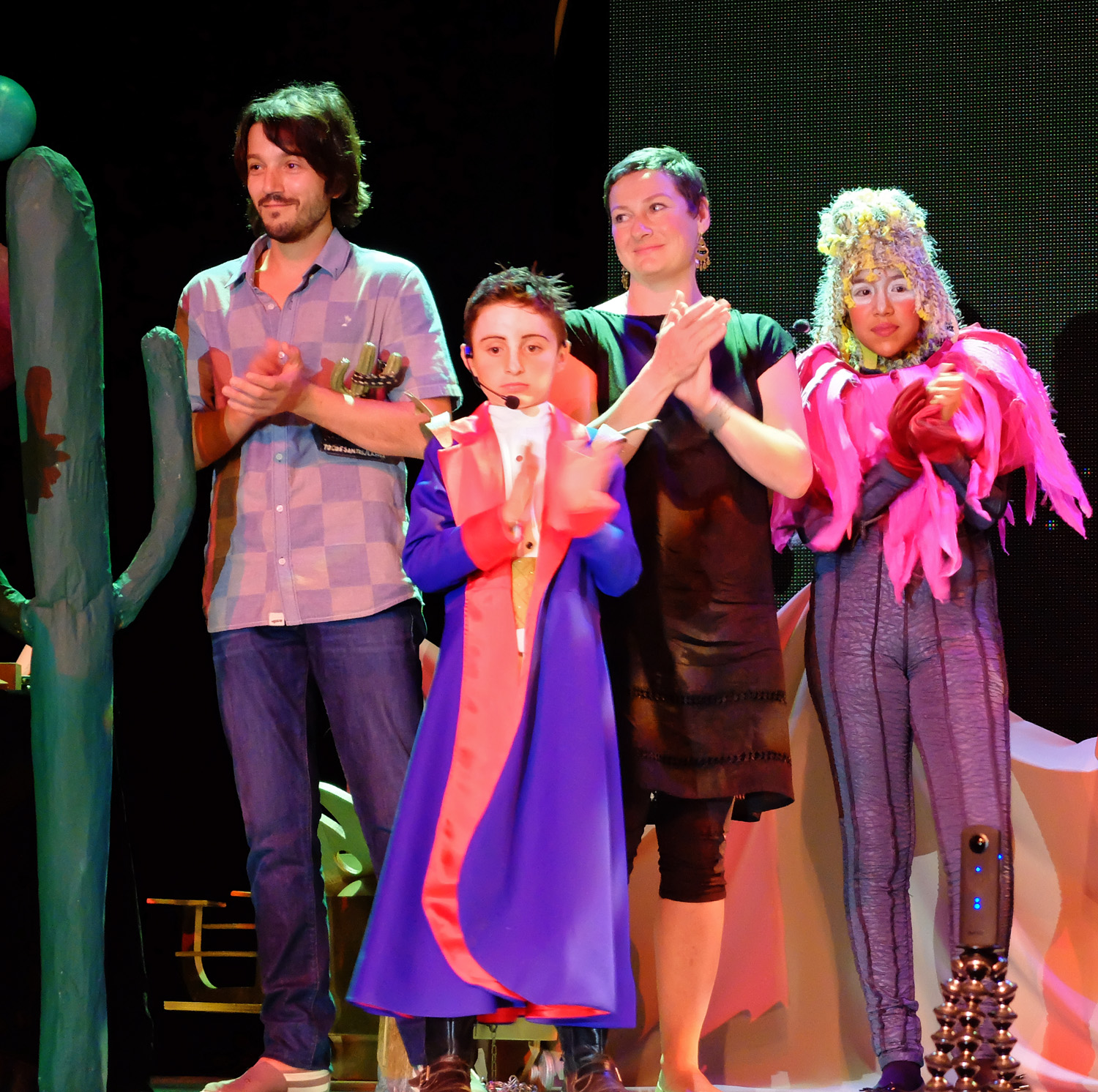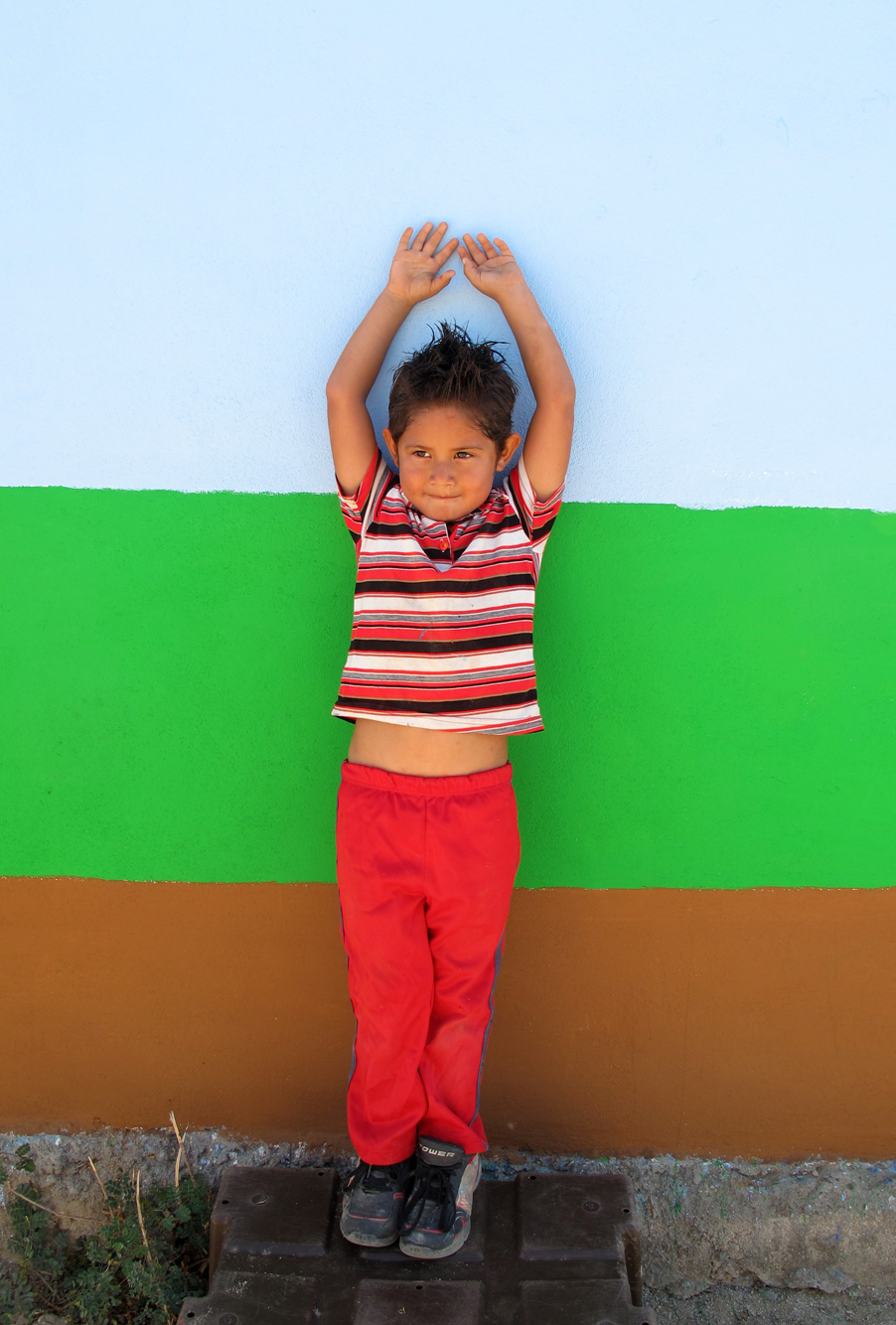ZOËLAB: THE LIFE AS ART BLOG
Zoë's Mediterranean Salad
Finally publishing my famous Mediterranean Salad Recipe!
Well this is a first for me. My very first blog post about food. It's not that I don't love eating or love talking about food, but I have never loved writing about food. It's one of a few subjects that doesn't really grab me. But, I've been receiving so many requests lately by my friends who live in Baja, where it's still hot, who are looking for ideas of recipes they can make with out cooking. So I have decided I am finally going to share my famous chickpea salad recipe that I invented about 12 years ago, and have been perfecting ever since.
It all started in Oakland, when my friend Marie came over for lunch and I made several different Mediterranean-inspired dishes - fava bean salad, tabouli, greek salad. There were a lot of leftovers, and I combined them and thought, wow, that's even more delicious! For the first several years of making this dish I used whole wheat couscous, until I realized that it was much easier to find rice in Baja, and it tasted even better with rice.
So here is the current version of this salad. It's a one pot meal, as they say, which is fabulous to take to picnics and potlucks. And includes all the food groups (except meat). You can omit the feta cheese if you want, and then it's a vegan meal too!
Oh, and I must mention this is one of my all time favorite meals that my whole family loves.
Zoë's Chopped Mediterranean Salad
(serves 4-6 as a main dish, with lots of leftovers)
1 cup rice (White or Brown)
3 cans chickpeas (depending on taste)
1 cucumber, peeled
1 red pepper
1 yellow pepper
A few handfuls of cherry tomatoes halved (or chopped tomatoes)
1 green apple (other varieties will do as well)
1 sweet white onion
1 bunch of green onions
1 bunch of finely chopped parsley
1 bunch of finely chopped mint
1 - 2 lemons (depending on taste)
Feta Cheese (optional if you are vegan) (amount to taste)
Olive Oil
Chopped toasted almonds
Cayenne (optional)
Cook the rice ahead of time and let cool completely. Drain the chickpeas and rinse. Chop all ingredients into bite size cubes and throw them into a large bowl. Mix them completely and then add olive oil and lemon to taste. Keep stirring and keep tasting until you are pleased with the balance. Add plenty of salt and pepper and I love a bit of cayenne as well. Serve with the toasted almonds on the side, as you will have leftovers and the almonds should not be left mixed with the salad lest they become soggy. If you serve it the next day, I recommend squeezing additional lemon on right before you eat it as the acid mellows over time.
Of course there are endless variations on this dish, but I recommend you try this recipe first and then start substituting and playing. Feel free to comment below with your substitutions.
For those of you who live in Southern Baja, I recommend the feta cheese from El Sol market. It's in the fridge, in the cheese section. It comes in an unlabelled clear plastic container, and it's local and delicious. One container should be enough for one dish.
Mexico City Photo Essay
Visiting a less familiar city is always a fun opportunity to bust out my Fuji x100 to capture some street photography
In May, Lucas, Emilio and I went to Mexico City, now nicknamed CDMX, to finish up the paperwork process of getting our Mexican citizenship.
Visiting a less familiar city is always a fun opportunity to bust out my Fuji x100 to capture some street photography. Living on a dirt road in the desert does not offer too many of these chances. For the first 35 years of my life, I lived in cities--New York and then SF, and Oakland and walking around with my camera is a welcome return to my former life.
The hotel we stayed at was in the downtown and very close to China Town. I have a history of living in Chinatown and have had an affinity for Chinese culture since I was a child. I also studied Chinese for 7 years as a youth! So it was super fun to capture both Mexican and Chinese culture in some of these shots.
Mexico City is a fun place, but I must admit that I have become accustomed to a slower, quieter, less populated way of life, and I get overwhelmed by large cities now.
We ate tacos at our favorite Taqueria: La Auténtica. I stopped eating "red meat" a year ago for no other reason than my body tells me not to eat it, but I do eat an occasional taco al pastor, which is pork, and I've heard is considered "the other white meat." Their al pastor tacos are the best I've ever had. I also love their little plates of nopal, and their quintet of salsas is incredible. I had to keep ordering totopos so I could have a vehicle for more salsa. We discovered La Autentica the last time we went to Mexico City, and that was when we first heard this powerfully moving song, El Paciente by Alfredo Olivas. It would be a high challenge, especially to sing, but some day I would like to do a Zoë + The Mischief rock and roll cover of it.
Anyway, our little trip was successful and we left as Mexican Citizens!
Driving North on Independence Day
A photo essay of our road trip from Elias Calles, BCS to Los Angeles California
Road Trip (2012)
Road trips, for me, are usually both very difficult (due to the boredom, feelings of disempowerment, and lack of exercise) and very fun (sense of family adventure, opportunities for long, process conversations, visual stimulation, fun with camera). We’ll see how this one goes....
ZOELAB DAY 80
Date of Original Post: November 19, 2012
This afternoon we are leaving for our drive up North for the purpose of getting the last of our stuff (including our vintage pachinko machines) out of storage in Northern California. Lucas did this trip a month ago, thinking it would be the last, but he couldn’t quite fit it all in the trailer. So, this will really be the final trip. (It better be!) We will stop for a few days in LA to visit with friends too. My internet access will be unpredictable over the next few days, but I will keep up my ZOELAB on my computer as much as possible.
Lucas has done the roundtrip Baja road trip at least 30 times since 2004. I’ve probably done it about six or seven times. This will be Emilio’s fifth time--his first was when he was not yet two months old. The first time Lucas and I did the drive was in 2004, after we had moved from Brooklyn. Before moving to San Francisco for me to start graduate school, we decided to go to San Jose del Cabo to visit with Lucas’ sister Emilia for a few months. We had bought a 1964 VW bug through Craigslist San Jose, California, from a father and son who, as a project together, had built it up as a Baja 1000 racing car with: 1835 cc, dual carbs, big head valves, transmission swap, 33 inch racing tires in the rear, full roll cage, racing seats with 5 point harnesses. The interior was stripped down to the metal to save weight. (No, I don’t know that much about cars. Luckily I have Lucas sitting next to me to give me all the specs from his engineer’s brain.) In other words, it was extremely fast, for a bug. Lucas raced a Porche in LA and beat it, but only because the other driver knew that Lucas didn’t mind scratching the paint of his car. And Lucas knew that the other driver knew that our entire car was worth less than his paint job. Needless to say, the LA driver was very angry. Because of the racing motor, when we went more than 30 miles an hour, it was so loud inside the bug that we couldn’t listen to any music, let alone hear each others voices. We had installed an old intercom headset system from an old airplane, but it was just too uncomfortable to wear for the long drive. The starter motor died 10 miles into the trip, and we had to push start it the remaining 1600 miles. Even in California, when we had to push start the bocho (what VW Bugs are called in Mexico), Mexican men magically came out of nowhere to help us push. We made it down to San Jose del Cabo in four or five days, with our ears ringing from the loud car. I don’t have the photos of that road trip right now to share, but I will post them when I find them.
Road trips, for me, are usually both very difficult (due to the boredom, feelings of disempowerment, and lack of exercise) and very fun (sense of family adventure, opportunities for long, process conversations, visual stimulation, fun with camera). We’ll see how this one goes....
First Open Reading, Part One
Because it is an open reading, anyone can read something. The only parameters are that you must read an original work, and you must keep it at five minutes or less. This week, after four years of putting it off, I decided that it was time for me to read something. I guess I was just ready.
ZOELAB DAY 107
Original Date of Post: Sunday, December 16, 2012
Today I participated in my first “open reading.” In Todos Santos, a town close to where we live, a married gringo couple has been holding once a month open readings for many years at an open air restaurant inside an art gallery. I had been hearing and reading announcements about it for the four years that I have lived here, and I would always think to myself, ‘I should do that!’, but I had never attended it, until yesterday.
Because it is an open reading, anyone can read something. The only parameters are that you must read an original work, and you must keep it at five minutes or less. This week, after four years of putting it off, I decided that it was time for me to read something. I guess I was just ready.
A few months ago I received an email from a man, who wrote about what a good writer I was and was curious to know about my writing process. At first I was overjoyed to receive a compliment, but then I realized I had no idea who the person was who was writing me, and that he wasn’t actually writing to me. (He was writing to my personal email so I knew he wasn’t writing about ZOELAB.) By googling him, I found out he was one of the people who ran the open reading. I emailed him back to let him know his email came to me by mistake. It turned out he meant to be writing to a different Zoë--but somehow had sent it to my email instead.
The Zoë he was writing to is 13 years old. I found out later, that she had been taking a writing class with the him and he was giving her feedback via email. The other Zoë I also know as she and her brother are close friends with the two sisters I taught a film class to, which resulted in a 6 minute film that the girls (11 and 13 who were 10 and 12 when we started) wrote, directed, and acted in. Anyway, I knew the other Zoë, and her brother, also, because I had given each of them a haircut several years ago. Her brother who was 7 at the time, had requested a mohawk. I was nervous I’d get in trouble with his parents if I did it, so I gave him a “normal” looking haircut and just styled his hair to look like a mohawk. A week ago, I received another email from the organizer of the open reading, again by accident, this one thanking the participants for sharing their work. I decided it was a sign from the universe that I needed to read something at the open reading.
I knew right away what I wanted to read. The two part piece I wrote about my brother--GeGe & MeiMei (the Chinese words for older brother and younger sister). I chose it because it was both light and open hearted, and because I had received more feedback about it than any other piece I’ve written. Also, I had recently received an email from my brother entitled “designer jeans.” I decided to share the words from my brother at the reading. I practiced reading the piece aloud to see how long it would take, I put my timer on and it beeped half way through. So I had to edit it, and quickly, as I had to leave in thirty minutes. I crossed out paragraphs and sections, timed myself again, and knew it was still too long, so I picked a few more lines to take out. I had never edited something so quickly in my life, and it was freeing to do it. I felt like I was flying by the seat of my pants, and that, for some reason, is the style in which I like to do things. In fact, the best advice I ever got from a writing teacher was to edit in an intuitive way rather than in a mental way. Play with your words, and let yourself sense what doesn’t need to be there. In this case, it was easy as I had no choice, and it was just a temporary restructuring.
To be continued...
Creatures Night and Day
There is something to be said for peeing under the stars. Where the crickets can see you. I can hear them now with their staccato siren call. A surround sound symphony easing me into night.
ZOELAB DAY 94
Original Date of Post: December 3 2012
There is something to be said for peeing under the stars. Where the crickets can see you. I can hear them now with their staccato siren call. A surround sound symphony easing me into night.
And the stars, they are here to remind me how empty I am, that there are star-sized spaces inside. And the moths, with their lamp worship, inspire and disgust me with their number and their diligence. In the morning, they are still there, calmer now, just sleeping through the day, where all light is equal.
To really arrive here, at home, is a relief. Living with the creatures, I find my way towards acceptance. We both can be ruthless.
Today I destroyed a black widow nursery. Maybe. The tiny soft sacs cradled in web nests under the seat of the wrought iron chair. I poked them with the tips of the gardening shears I found yesterday. Then I saw the mamma, but I could not identify her in the book. I stomped on her with out knowing if she was dangerous. I, with my foot and my gardening shears, was dangerous. I spoke to her as I killed her, and I felt it. The brutality of nature. It’s that way sometimes, when we have someone we need to protect.
Backwards Night Dreaming of Camp, Illustrated
ZOELAB DAY 79
Here are some photographs that illustrate some of my pluses and minuses of living outside list from yesterday's post:
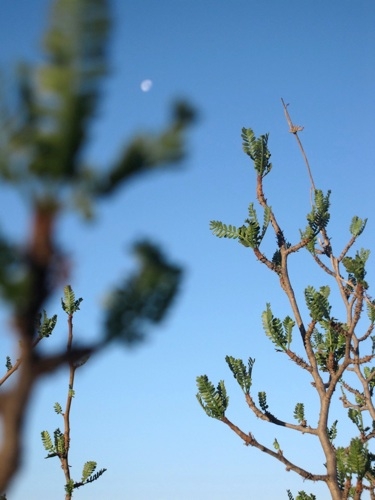
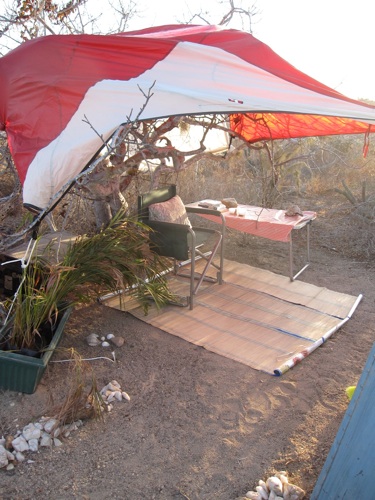

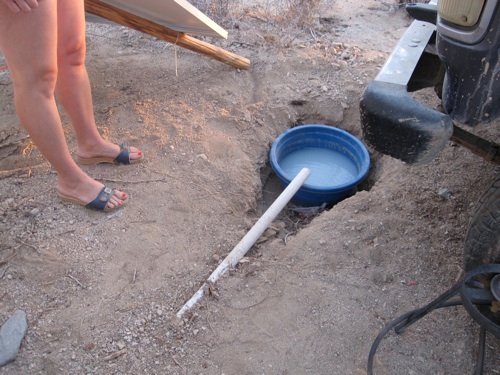


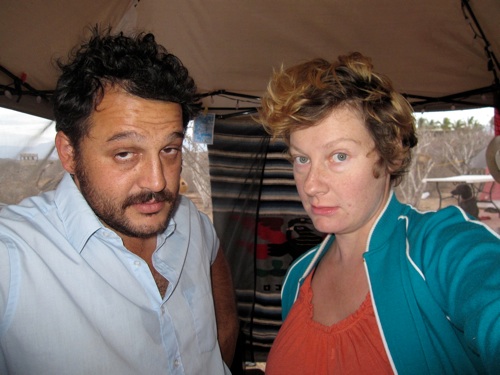

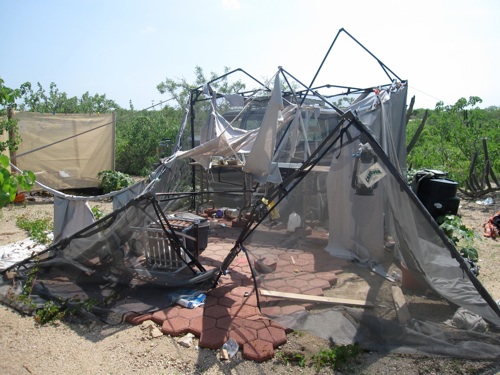
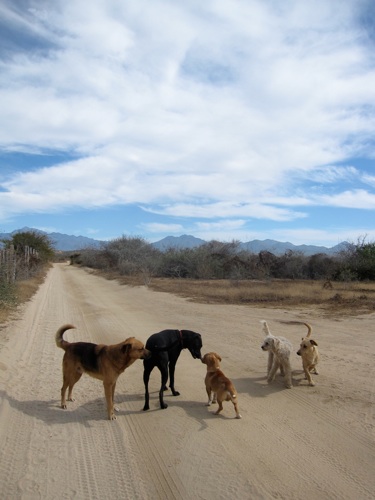
Check out our Camp Video.
Better on the outside than on the inside
When we first arrived in Baja, and I was pregnant and we were camping on our land in Elias Calles, I wasn’t legal to work yet, but I needed to do something to occupy my time, to meet people, be of service, and to have a creative outlet. I decided to volunteer for the women’s organization, Manos Magicas.
When we first arrived in Baja, and I was pregnant and we were camping on our land in Elias Calles, I wasn’t legal to work yet, but I needed to do something to occupy my time, to meet people, be of service, and to have a creative outlet. I decided to volunteer for the women’s organization, Manos Magicas. It’s a small group of women (Mexican, American & French) who met (and still meet) weekly in Todos Santos dedicated to helping women learn skills using their hands: sewing, knitting, making for the purpose of learning, community building and financial independence. The same day I showed up to volunteer, Marcela, and her boyfriend Sigfrido, showed up for the first time too. They were young, younger than me, and scrappy, scrappier than me. They were also from the big city, living on their raw piece of land, camping or more like squatting in their quarter-built house. It was a relief to make some young friends, who were Mexican, who spoke perfect English. We spent all our time together our first summer in Baja, and Marcela taught me many things in Spanish. One of my favorites was an expression in Spanish, that I immediately forgot, but adopted into my own vernacular in English, which translated to: better on the outside than the outside. She said this to me every time I burped, which was often, as I had an addiction to bubbly water and coke. Coca Cola that is. Mexican Coca Cola, which is holier than American coke because it has real sugar rather than high fructose corn syrup. A friend told me that Mexican coke is a high value item in the US now for $3 a bottle. But I digress.
The point is that Marcela introduced me to this expression as a way to make me feel better about my burping. And you know what? It worked. Because of her phrase, burping, or even farting, felt more like a celebration than something I should cover up or apologize for. After all, it’s better on the outside than on the inside. It also became a joke between us—the more pregnant I got, the more I felt that this phrase applied to me, not just about gas, but about the baby. I really wanted him out.
At first, I had wanted the birth to be 100% natural, hippie style. I interviewed a midwife. I read books about how empowering an all natural pregnancy was. I drew drawings of my unborn baby. (There's another wonderful story here about the drawing I drew, but I'll save it for another time.) When I found out that the baby (now the force known as Emilio) had the umbilical cord wrapped around his neck and that I would have to deliver him in a hospital, and that Lucas would not be allowed to accompany me in the delivery room, I opted for the cesarean section, which was what Doctor Ariola recommended. (Yes my OBGYN was named Ariola). I was devastated at first, I hadn’t imagined myself to be the kind of person that had a c-section, it just didn’t seem part of the narrative. But then again, no mother has the birth she imagines. It’s the first lesson of motherhood. Things not going according to plan. Eventually, I had come to accept the cesarean, as scared as I was. After all, no matter how it happens, better on the outside than the inside. That was what was most important.
The day Emilio arrived on this side of life, outside the womb that is, was not the happiest day of my life, as so many parents claim. The day after his birth was possibly the worst day of my life. (Also another story.) That doesn’t mean I didn’t love the little thing as he first nursed me, both of us having no idea of how it’s supposed to happen, just knowing that it is. The first time I heard his voice, as I lay drugged out on the operation table, I burst into tears. It was a loud sharp cry announcing his lungs to the world, to us, his parents. The sound of his voice was a great relief, and proof, undeniable proof, even more so than seeing him, or holding him, that he was alive, and here. That he is a whole person, separate and individual and able to make sound. Then Lucas showed him to me and I was surprised by the darkness of his hair, and the amount of it. He seemed small, but somehow powerful already. A force of nature. He was so so much better on the outside than on the inside.
It’s not that it was a difficult or painful pregnancy. Things went smoothly mostly—at least his part did. He grew, and grew. And I grew and grew along with him. There was not a lot of pain and only a small amount of discomfort, which mostly resulted in the fact that we were living outside, in the desert sun, and I was hotter than normal, and could never seem to find enough shade or coolness to feel comfortable, until night time, which was when I retired, at 9 PM, to the tent, ready for profound rest. Mostly, I took long walks on the beach, alone, or with Lucas, looking for shells and rocks to add to our collection. I was somehow able to stay very present, not thinking too far in the future—how are we going to raise this child? What kind of education is he going to have? Those thoughts, the thoughts that most of my friends and family asked, did not even occur to me at all. I knew instinctively that all my energy needed to go into growing this being and putting all my creativity into that, not through drawing or writing or singing, the way I was used to doing, but just through being. Through soaking in the fresh ions from the ocean waves and the moments of pleasure when I could enjoy food. My pregnancy experience was unconventional, to say the least, and not even in line with the kind of person I had been before. I wasn’t much of a camper, or a nature girl. I had always loved nature, and had enjoyed camping the few times I had done it. But, camping was more like a background to some other kind of art project or experience. I didn’t have a very direct relationship to nature. Every plant I had ever owned had died. The first time I went camping with Lucas, I referred to the forest as “in here” as in “hey it’s getting dark in here as the day faded into night.” I admit I said it partly in jest, to play up the Brooklyn part of me, the part of me that is, as Woody Allen used to say, at two with nature. But the larger and deeper truth is that I am a hippie deep inside. I have never worn patchouli oil, and I do not have long stringy hair. I never really dug the grateful dead (though some of their songs are pretty catchy, I admit), and I never call people “man” or use the word “groovy.” But inside, I am about as hippie as you get. I believe in peace and love truly and madly. I believe almost everyone is too uptight, or at least spend some more time in nature contemplating the sky. I often feel I wasn’t really made for the world that I became myself in—I feel far too large, and strange and messy and indefinable.
Now, six years later, the term better on the outside than on the inside can refer to just about everything that’s important to me. It has become a central theme of my work. What is inside? Or rather, what do we keep inside? What do we not show? This is what I am most interested in. Sometimes it’s just trapped gas, or a baby that isn’t ready to be be born, but other times its the fear that is just beyond the reach of our awareness, or the really rough novel we’re writing in secret, or the dream we dare not share in case someone else laughs or judges us, or the tear just under the surface of the duct, that would prove our fallibility if were to appear in the corner of our eye.
Yes. I say, better on the outside than on the inside lest that feeling, or thought, or work of art stays stagnant and unfelt, unimagined, unlived. We are lucky to be born into this world, and if we are alive, then we are meant to live. We can barely live if we cannot let what is inside, out. I know this from experience. I have had times in my life where I did not want to live because I could not transmit my inner world. The loneliness of being shut out from our very own liveliness is heartbreaking and often, dangerous. I believe our humanity is at stake when it comes to whether or not we can forge through our fear and risk emotional, mental and artistic expression.
I say, yes, always yes, it is better on the outside than on the inside.
Marcela, if you are reading this, please do send me the Spanish version of that saying.
Our land when we first arrived on it. Our French friends helped us clear the land to make space for our camp.
Marcela & Sigfrido at their home. We called them Sigcela.
7.5 months pregnant at Cerritos Beach.
Showing off our solar panel at our camp.
Learning how to make rugs from fabric scraps at Manos Magicas.
Two months after Emilio was born.
El Principito En Baja: Behind The Scenes and on The Stage
The story of the multi-media production, the cast & crew, photos and a song!
On Wednesday, March 16th, the premier of El Principito en Baja was performed at the historic Teatro de Márquez de León Theater in Todos Santos. The play was an adaptation of Antoine de Saint-Exupéry’s classic book, The Little Prince, re-written for the stage by David Liles and Sylvia Perel, Founder and Director of the Festival de Cine Todos Santos, with some additions and re-imaginings to include the local context of Todos Santos, Baja California Sur, which is under environmental threat by goldmining industry. There were two performances--the morning matinee which was viewed by over 200 schoolchildren, (including the Elias Calles school where my son attends) and the evening, which kicked off the 13th annual Festival de Cine Todos Santos - La Paz, raised money for the Jóvenes en Video program, a program of the ten year running Leonardo Perel Film School, (founded by Sylvia Perel's late husband) and the only film school in Baja California Sur. The second performance was attended by a highly enthusiastic audience, which included Mexican actor, director and producer, Diego Luna.
Work on the play started in the summer of 2015, as part of a series of free summer workshops that involved more than 60 local kids learning film-making, animation and acting. 5 of those kids Esli, 18, (EL PILOTO), Lucas, 8 (EL PRINCIPITO) , Emilia, 10 (EL MANANTIAL y LA CASCABEL), Maria José, 13 (LA FLOR y EL DRAGON) and Hannah, 12 (EL EMPRESARIO y EL COYOTE) were cast for the main characters and rehearsed for eight months. The cast was later joined by three wonderful girls: Lía, (FLOR) Fernanda, (FLOR) y Susje (FLOR). Starting with the YOUTH EN VIDEO workshops, the kids created masks, characters, memorized lines, stage directions, learned songs and even some dancing. The youth from JOVENES EN VIDEO (Dora, Frida, Juan, Raquel taught by Prof. Mike Henaine) captured this creative process in their documentary, Detrás de las Escenas del Principito en Baja (Behind The Scenes of the Little Prince en Baja), which will be screened at 3 PM on Monday, March 21st at Teatro Manuel Márquez de León. Admission is Free. The JÓVENES EN VIDEO also created the charming animated videos and stunning footage capturing the natural beauty of Baja that were projected on the LED screen behind the actors to add scenery and meaning to this beautiful multimedia theatrical production, whose theme was protecting the natural beauty of Baja.
Last July, Sylvia Perel asked me to help her with the production, which was originally supposed to be performed in October. At that time, I was helping as creative consultant, and attending some of the rehearsals, not really sure the best way to help. I tried to pull in more actors, and brough in some visual ideas, but my real role did not start until November, when Sylvia told me that La Flor was supposed to sing a song. I told her I was a songwriter, and that I would write one. That night I poured over the script in Spanish, and the original book and wrote my first song en Español. I had some help with the Spanish from Sylvia Perel and Silvia Padilla, (my Spanish teacher and English student, and my neighbor and friend.) And Por Ti (La Canción de la Flor) was born! There was this extra part at the end, that I couldn't figure out how to connect to the rest of the song. It just didn't fit. After a few weeks of trying to make it work, I suddenly realized the ending to that song was really its own song, and that it could be the finale of the play! A few weeks later, Sylvia told me they needed additional music and sound to enhance and tie in the performances. I immediately agreed, and that was how I became the Musical Director of the play. I am immensely proud and happy to have had the opportunity to collaborate with and meet so many creative local talents and to have been involved in such a heartfelt, and beautiful production with such an important message. Wednesday's performance, and all the hours of work that led up to it, was truly a creative highlight of my life. I hope that I will collaborate with the JÓVENES EN VIDEO in the future--I already have several ideas for projects in mind. This production was a great opportunity for me to practice teaching in Spanish, and my goal is to collaborate more with children in BCS gives me more motivation to improve my Spanish.
Here is the recording of Por Ti that I made, which was featured in the play. I hope Maria José, the girl who played the flower and who sang the song, will join me on April 14th to sing it with me at my next gig in at La Esquina. I plan to do another recording of the song, with all the verses and both of our voices.
Here is the complete list of cast and crew:
Dirección/Producción Sylvia Perel
Guión /Script Sylvia Perel & David Liles
Producción Ejecutiva. Patricia Fernández Millán
Dirección de Actores/ Acting Teacher Prof. Guillermina Sainz
Producción Técnica/ Tech Production Rogelio Muñoz Camacho
Escenografía/Set Designing Wesley Horn
Vestuario/Costumes Clara Gaucín
Música/Music Zoë Dearborn
Iluminación/Lighting design Franciso Zuñiga
Objetos /Props Salvador Cadena (Chava)
Actores/Actors Esli Mejía, Lucas Cano Sanchez , Emilia Cano Sanchez, Maria José Favela, Rosita Orozco, Lía Romero, Fernanda Murillo. Susje Torres.
Producción Visual : Jóvenes en Video, Prof. Mike Henaine, Dora Juliana Martinez, Frida Cota, Juan Manuel Agúndez, Raquel León Gonzalez
Logística/Logistic Angie Ontiveros
Efectos digitales, mapping e instalación: MUV Marco Gaviño, Rolando González e Iván Rodríguez.
For more information, check the Festival de Cine Website.
Here is the recording of Por Ti that I made, which was featured in the play. I hope Maria José, the girl who played the flower and who sang the song, will join me on April 14th to sing it with me at my next gig in at La Esquina. I plan to do another recording of the song, with all the verses and both of our voices.
The Story of Inside/Outside Ping Continues
Ping used to be a city dog, and so was I. He went on regular walks on hard side walks—sniffing the other dogs’ messages. He was cooped up all day in our apartment, and tried to escape every chance he got, and succeeded several times, creating heart-pounding adventures for us, and for him. Once, he was able to sneak into our upstairs’ neighbor’s apartment and finish their left over chocolate birthday cake, another time he ran across the street, a main highway in Oakland with very fast cars and ended up in trapped in someone’s backyard.
Ping used to be a city dog, and so was I. He went on regular walks on hard side walks—sniffing the other dogs’ messages. He was cooped up all day in our apartment, and tried to escape every chance he got, and succeeded several times, creating heart-pounding adventures for us, and for him. Once, he was able to sneak into our upstairs’ neighbor’s apartment and finish their left over chocolate birthday cake, another time he ran across the street, a main highway in Oakland with very fast cars, and ended up trapped in someone’s backyard.
In 2009, Lucas and I packed our 1980’s Toyota Land Cruiser (which waited until we arrived at our destination before it literally collapsed and was never driven again) with a small percentage of our enormous amount of belongings, as well as Ping, and with our unborn son in my belly, we drove down the Baja Peninsula from the Bay Area, to meet our uncertain destiny. We had some savings, a piece of raw land that we didn’t yet own, and some used camping gear, and that was about it.
Ping adjusted to country living quite quickly, and soon found his true calling as at the best watch dog in the world. He has a skittish and serious nature that lends itself well to barking at anything that moves, including pieces of dust and figments of his imagination. We live on a homestead that is one and a half acres in the middle of what is called a Tropical desert. In the summer it’s like living in the tropics, we are prone to hurricanes, loads of bugs, heat, and humidity, but also the desert turns bright green, and wildflowers bloom all over the valley. During the winter it is cool in the evening, and warm and crispy dry, during the day, but the landscape is brown and crusty. Nature makes sure to deliver a gift with every loss, and a devastation with every gain.
Since arriving in Baja, Ping is free to roam the land, smelling and exploring whatever he wants. Barking at whomever he wishes to bark at (real or imaginary). His beast nature is in alignment with… well, nature. This arrangement is blissful for him, as well as for us, but it also has its down sides. Being a country dog means he is covered in dust, fleas & ticks—this made him go from an inside to purely outside dog. He was no longer an inside dog. I really missed that part of my relationship to Ping, as inside tended to be way I had mostly connected with him. He is my first dog, and as a child, I feared dogs, not understanding that barking was a form of communication and not an aggressive act meant to destroy me. When Ping first barked loudly at me, as a puppy, out of frustration, I cried, I was afraid he was going to bite me. My husband laughed at me. But since, I have learned to trust him deeply—and happily stick my hand inside his mouth, whenever necessary.
Two summers ago, there were a lot of lightning & thunderstorms. We live at the foothills of the Sierra de Laguna mountain range—and are prone to all sorts of mountain weather. The sound of thunder, as is true with most dogs, often triggers a flight response in Ping. Sometimes he cowers in the corner, shaking, but many other times, if he can, he runs with no thought to where he is going. He runs straight for the highway, as fast as his long legs can carry him, which is very, very fast. This happened a few times when we were not at home, and he got hurt—once being hit a little by a car, luckily only a little graze, and another time, he had ripped the pad off of one of his paws. The sight of this was unbearable, as you can imagine, but he recovered.
We realized that if we wanted to keep Ping alive, we would have to turn him back into an inside dog, or rather an inside/outside dog that has to be locked up when we leave the house, just in case thunder comes, and he runs. This shift has meant yet another major quality of life increase for Ping. He now officially has the best of all worlds. The comfort and coziness of the indoor human lifestyle, mixed with the sheer raw freedom of beasting around outside. (This is what we all have, if we take advantage of it. Emilio, now 6 certainly does.) Ping’s updated status has benefited me, as well. We are closer again, and I am more aware of his presence, and our relationship. I admit it is my habitual nature, of being a city girl for 35 years of my life (though I spent most summers in the countryside), to be an inside person. We live in such a gorgeous spot of raw nature, and yet I spend most of my time indoors. I really do forget to go outside, if I don’t have to. We live half a mile from the beach, but I can’t even remember the last time I walked on the sand. Fortunately, we have set up our homestead in such a way that it requires leaving the house. We have two buildings (and a third guesthouse is currently in construction, more on that project in a future post)—a kitchen casita, which is one main room, with a small kitchen, living and dining room. (It also includes a space that has evolved into a music practice space and recording studio. More on that later as well.) And then the other building is our bedroom—2 bedrooms and a bathroom. (Another side note: Emilio just spent his first whole night sleeping alone in his bedroom, with the help of a brand new Star Wars Bad Guy Cozy Blanket). We have an additional bathroom, just outside the main space—adjoining the front patio. This requires leaving the front door to go to the bathroom. This might sound inconvenient to some people, who are accustomed to a different lifestyle. But it is so great that I must leave the house in order to change clothes, take a shower, or go to the toilet. At night, during my short walk from the living room to the bedroom, I always make sure to pause and look up at the sky, and it always reminds me of why we live here. So that we will never forget the stars. So we will never forget that we are nothing with out nature, and that nature is within us, as well as around us. I forget this every day of my life, but everyday, something always shows up to remind me.
Last week, Ping received his first treatment for Heart Worms, which is a parasite that can affect a dog’s heart—causing to enlarge it and make it work extra hard. His treatment went well, but now he has to be kept from getting excited for 2 weeks. This means no roaming free, no running & barking after dogs or cows or mosquitos. This means being back on a leash for peeing and pooping. So today, I took Ping on his first morning walk. I was impatient—trying to rush his process. Not letting him check every scent he wanted to check, not letting him take the path he wanted to take. It was the busy time of the morning, and I had to get Emilio ready for school. I had to drink my coveted coffee. I had to get back inside. After a short walk where he peed/made his mark a few times, I took him back in the house so I could continue with my indoor morning routine. I took Emilio to school and when I came back Ping was barking politely at the door. Lucas said: “He needs something and I have to go, can you take care of it?” I said” “He doesn’t need something. I already took him out, he just wants something.” I took him out again, grumbling. Once outside, he insisted on walking down the deep slope towards the arroyo (dry river bed) near our house. He stopped several times to sniff, and continue his peeing/mark making. Then after several minutes of walking, he found his spot to poop. Then I started to relax more—realizing that this is his usual outside routine, which happens while I am “busy” with my inside routine: writing emails on my computer, or fretting about some imagined event in the future. I had a moment of deep compassion for him, remembering that he is a beast, and he needs to do his thing, outside. And then I thought this is yet another blessing of something that could easily have been dismissed as “annoying” or “inconvenient,” but really was a wonderful opportunity to get out of my head, and observe the isness of nature. It’s always there, we just usually ignore it. But animals, they can’t ignore it. It’s necessary to them. And I believe it is necessary to us too, after all, are we not animals as well as human beings?
Do you have a story where an animal or other aspect of nature taught you or reminded you of something unexpected, or took you out of your unconscious routine?
p.s. It also must be noted that Mexico is Ping's third country of residence. He was born in Taiwan, and was rescued from being lunch by a woman who flies all over Asia rescuing dog's from being eaten, and then flies them back to the US to be adopted.
Jardin de Niño Diaries, Part Four
And then one day Vanessa asks me—maybe we can use the money to buy paint for the school? Of course. Why did I not think of that? I buy paint for the background, for the mural and for the classroom.
We break for summer and I decide that when school starts again in August, I am going to start the mural project. This will require planning. This is not my strong point. I have never painted a mural before. Here's my idea: to paint a jardin de niños literally. I want the mural to be a garden of children who are half kids/half trees, cactus, flowers and plants. The wall had been painted again and so I already have a good background for the mural. The first plan is to trace the kids bodies in the form of the plant they want to be. I use a permanent marker. I write their names on each outline.
Then hurricane odile hits Baja. When we check out the school we see that the entire roof and one of the walls to the outside classroom is gone. There are papers and books and garbage everywhere. I look at the other wall. The paint is gone, and so is the permanent marker outline of the kids bodies. Not a big deal to re-do, but it is a bit shocking what wind can do. The building got a power wash.
The hurricane pulls the rug from under us. Everyone is in shock. We continue to live in fear of the next one. Or the rain. Any rain. Slowly the creatures come out of hiding and I want to reach through the isolation. I decide I am going to start hosting the first Mariposa Night. The theme is "Stories of the Storm." I start to ask people to share their stories. Again, reaching beyond my shyness into connection with others. It starts out a bit clumsy. I am unpracticed after being a holed up hermit all summer. I wonder if people are ready to come out of hiding. I want to draw them out. I want to draw myself out.
Lucas suggests I try to raise money for to rebuild the Elias Calles school. Then I think of Vanessa, the teacher—how she could share her story of the hurricane and her experience at the Elias Calles school. She is shy too, and very young and inexperienced, but she knows it will help raise money.
On Mariposa Night Lucas picks her up on the way to Todos Santos. She is all dolled up, with makeup and her hair down. She looks beautiful and nervous when she arrives. We buy her a margarita that costs more than her weekly salary. Then I wonder if she is old enough to drink. I am nervous too. We tell our stories and Vanessa is last she shares her concern for her “pollitos” little chicks, expressing a deep affection for the kids and the community in Elias Calles. They have taken her in, even though she lives in La Paz. We raise 1800 pesos. About $130.
The money sits in a jar in our house for months. My classes start at Cuatro Vientos, and I don’t have time to even think about the mural. And then one day Vanessa asks me—maybe we can use the money to buy paint for the school? Of course. Why did I not think of that? I buy paint for the background, for the mural and for the classroom. The week before that Vanessa had asked the parents to come and clean the school yard. It had not been cleaned since the summer weeds grew, turned to grass, nor since the hurricane.
I arrive with Emilio and Lucas. Vanessa is there with her husband and infant son. A few other parents are there. I walk over with Emilio. I bring garbage bags to pick up the garbage that is scattered all over the school yard. The men are carting large amounts of cement rubble and dried weeds by wheelbarrow to a dump pile in the open field behind the school. We sweep, we throw away all the destroyed books. After a few hours of working in the twilight, the yard starts to look decent again.
The next week Vanessa informs the other parents that we will be painting and some of them show up that day. I have bought yellow for the inside of the school. The room is quite narrow, but big enough for this group of 4-10 kids (at any time the amount changes.) It was built to be the bodega of the school but the kids have been using it for their classroom. We paint the outside wall: blue for sky, green for grass, and brown for earth. The mural will be added in parts over the following weeks.
The following week week I ask the kids to choose if they will paint a flower, cactus or tree. Then I ask them to form the shape of their plant with their body, and I trace an outline in the wall in pencil.
What I have learned from my involvement with the school is how to be flexible. I often don’t know what’s going on, and I have little understanding during the meetings. Vanessa cancels class last minute when her baby is sick or she has some teacher related meeting she has to attend for her training. I have learned to absorb patience and humor when all else seems out of my hands. One time Vanessa forgot the key to school in her home in La Paz and the kids had to climb through the window for the entire week.
To be continued...
Last Day of Kindergarten
Yesterday was Emilio's last day of Kindergarten. Surely a day of mixed feelings for me. This day marks the end of early childhood, and the beginning of middle childhood.
Tadeo, Itzel, Jocelyn, Vanessa (La Maestra), Emilio, Marcito, Haide, Maria Jose, Antonio, Angel y Gralya in front of the mural project I did with the kids all year. Vanessa and I finished the mural the day after and added their names.
Yesterday was Emilio's last day of Kindergarten. Surely a day of mixed feelings for me. This day marks the end of early childhood, and the beginning of middle childhood. From the Freudian point of view, he is moving from the Oedipal phase that is marked by intense emotions, especially towards the parents, and a focus on the phallus (Freud was male centric) and into the Latency phase, which is more social, connected to the world of friends and people away from home which lasts until puberty. This new phase is the one I have least experience with as a teacher, a therapist, and a nanny. As with the end of every phase of parenting, I have mixed emotions. At first, when the realization hits me, I have a profound sense of loss where I cry cathartically for an hour, then I quickly recover, and feel a new sense of freedom and excitement about the unknown next phase.
I think for Emilio, who hasn't developed nostalgia yet, the day had less significance. Though he will be participating in a graduation ceremony in a few weeks, which is quite exciting due to its promise of sweet and a performance by the kids. Vanessa, the teacher, had requested that all the kids wear their uniforms the second to last day of school so we could take photos of the kids. The kids were supposed to wear their uniforms everyday. But as the year wore on, us parents stopped bothering to put their uniforms on the kids. Seeing them in their uniforms again, reminded me of the first day of school. Emilio had a great year in Kindergarten, and made great progress with his Spanish. He had extra help from our Peruvian neighbor and friend, Silvia, who is a very animated and fun teacher. She and I also do Spanish & English conversation once a week.
In Mexico, the Jardin de Niños includes both preschool and kindergarten, 3-5. At 6 the kids start primaria. In September, Emilio will be going to the primary school in Elias Calles, which shares the school yard with kindergarten. It is a two room school house--the kids, age 6-12 are split into two classrooms, taught be two teachers.
I started shooting photos of the kids in their uniforms, but then I realized Angel was missing. He is considered the rough kid, but I have a very special place in my heart for him. He has an artist's eye. I found Angel hiding in this tree. He was trying to avoid being in the photo, because he was the only kid with out a uniform. I pleaded with him to join the photo, but he was ashamed. Marcito's grandmother put a white playera on him, while he wiped the tears from his eyes. It was heartbreaking. But he did make into the photo. There he is below: second row, far right. Emilio is far left.
Gralya, first row, far left, didn't want to be in the photo either. But I have no idea why--she is pouting and separate for the photo on the top of this post, but now she is in the photo, but still pouting. She will be graduating along with Emilio.
Marcito and Itzel. Marcito will be graduating, but Itzel has two more years.
You may also enjoy:
DANCE LAB
Dance Lab is a chance for you to feel safe to move freely, developing your own body intuition and guidance. You will have the opportunity to rest, play, meditate, move, dance, create all in one class. You will leave feeling energized, and fresh—ready to celebrate the evening with friends, family or in sweet reflective repose.
I would like to share a little bit more about my class, Dance Lab. It is my newest Art For Life creation and I am very proud of it. It was born in confluence with the most beautiful yoga/movement/arts space in Todos Santos--Cuatro Vientos. This was a true experience of synergy--a lifetime of various experiences culminating in this class, with the perfect space.
I love leading the class, using a headset microphone for the first time--spouting out a spontaneous mix of poetry, guided meditation and movement suggestions. Teaching this class is one of the greatest joys in my life.
Dance Lab is a 75 minute meditation through stillness, movement, pilates and dance. Through all the levels and modes of Dance Lab—we develop our awareness of all the corners of our experience. Being experts and artists of our most authentic expression. Dance Lab is a chance for you to feel safe to move freely, developing your own body intuition and guidance. You will have the opportunity to rest, play, meditate, move, dance, create all in one class. You will leave feeling energized, and fresh—ready to celebrate the evening with friends, family or in sweet reflective repose.
Dance Lab was designed to create an opportunity for an intensive, personal work out of the body, mind and spirit. It was designed to gradually guide you into a deeper experience of yourself and your own creativity—increasing your range of expressiveness. As the music builds and the heat in your body builds, you integration mind, body and emotion, which ultimately leads you to the spiritual plane of unity within and without. As the sun sets, and the energy comes to a peak, you are returned to an upbeat, connected space of connection with both self and other, ready to welcome the evening with newfound energy, authenticity and joy.
Dance Lab is for those who want to develop their range of expressiveness through dance, or to have an authentic experience of movement and self connection and expression. It is also an incredible full body work out: designed to develop your concentration, mind/emotion/body awareness, loosen all the joints, work out and stretch the major muscle groups—with a special emphasis on the core through pilates exercises.
I have so far created 41 unique playlists since I launched this class on January 7th of this year. I have missed only one class due to illness.
Here is the playlist I created for today (I am proud to say it features music by two of my friends):
Ah, Breath Voices Silvia Nakkach
Compass Habit Trail Compass
Unison Björk Vespertine
Joga Björk Homogenic
Consequence The Notwist
Epliohunk Ratatat
Fidelity Regina Spektor
We Are the Wild Holly Mae and the Painted Room Turns of Phrase
Nocturnes Op.15 No.2 Fis-Dur Chopin
Cherry Ratatat
Heads Up Karen O the Kids
Big Time Sensuality Björk Electronica
Main Offender The Hives
Single Ladies (Put a Ring On It) Beyoncé
Hips Don't Lie Shakira ft Wyclef Jean
Quiet And Small Looper
Track 05 The Planet Sleeps
Jardin de Nino Diaries, Part Two
I have come to realize that at this point my only real chance to have a true cross cultural experience here in Baja (which is so full of gringos and so influenced by American culture) is through my involvement with the Elias Calles preschool. Even though I feel shy and intimidated, and struggle with communication, I push through it all knowing that this a great opportunity.
I have come to realize that at this point my only real chance to have a true cross cultural experience here in Baja (which is so full of gringos and so influenced by American culture) is through my involvement with the Elias Calles preschool. Even though I feel shy and intimidated, and struggle with communication, I push through it all knowing that this a great opportunity.
I want to share a little background on how I came to be involved with the school. The idea came from a combination of synchronistic events.
In the spring of 2013, Lucas hired Martín, a local worker and the nephew-in-law to our closest neighbor, to help us finish up some house projects. At one point, he and his wife, Idanya came over and helped finish the painting of our house. We soon learned from Martín that there was a “kinder” in Elias Calles, and that his 3 year old daughter (who is one month younger than Emilio) attended it. The 17 year old teacher, Vanessa, lived in their house with them. We had known there was a primary school (which was known as the best public school in Baja) where various teachers had come to do clay and filmmaking projects with the kids. There was even a film screened at the Todos Santos Film Festival called “Little Muddy Hands” that the kids made about their experience of learning to make clay. But, we didn’t know there was also a preschool. We had intended to send Emilio (when he turned 4 that August) to the preschool in Pescadero, the next town over. That preschool had 30 kids and I was already feeling nervous about sending him there, because he didn’t know any spanish. Or if he did, (after all he has lived in Mexico his whole life) he didn’t know that he knew.
Emilio on the first day we went to check out the school.
We were very excited that we could send Emilio to a local school, which was a walkable distance from our home. I walked to the school with Emilio, who rode his bike, the next day to meet the Vanessa, the teacher and find out the registration process.
A few days later I attended a friend’s "give away" party. She was giving away many items from her overcrowded van (her turtle home). One of the giveaways, was a children’s book called the Sign Painters Dream, about a grumpy old sign painter who transformed into a small town hero by painting a “glorious and magnificent” sign for a lady who wanted to give away apples from her orchard. At first he had laughed at the idea of making a sign for free, but after a haunting dream, he decided to make the sign for free for the lady who had asked him, which led him to re-discover his passion for sign painting. This story inspired me on many levels. (And have now added sign painting to my wish list of skill learning. In the meantime I have been teaching my self hand lettering. Which is also incredibly fun. More on this in the future.)
The way the preschool looked the first time we saw it. This is the "bodega side" of the school that the kids weren't using at the time.
The next day, after reading this story, my husband told me about a group of women who were doing community murals in La Paz (our nearest city)—they called themselves the Painting Pirates. I contacted them right away asking if I could be involved, thinking I could really learn something from them. I learned that painting pirates had already moved onto to another country. But then the next morning, it hit me. I could do my own project in Elias Calles onto of that sad looking wall of the preschool I had just seen. I went to talk to Vanessa, the teacher, the next day. In awkward Spanish, I communicated my plan. She liked the idea, and so I decided I would start when the school started again in August. August came and went, and I did not start with the kids. I was scared. I am the only gringa mother in the group. None of the others speak a word of English. My Spanish is pretty good in most cases, but not when speaking with someone who speaks only the strong local dialect. I really struggle speaking with Vanessa and the other parents. A lot of shame comes up in not being able to communicate. And in being different.
The first moment Emilio met Vanessa, his teacher.
The classroom as it looked at that time. It has since been destroyed by the hurricane Odile that came to visit us in September.
A few months went by and I still did not start the mural. I even asked the friend who had given me the sign painter’s dream for advice—she was an ex-artist and art teacher and had a lot of experience with murals and kids. Though I appreciated it, her advice caused me to be even more scared. Then I realized that I was jumping the gun, and that it would make more sense to start doing art projects with the kids, and get to know them first before I jumped into the mural. I could let the mural be a long drawn out process that we work towards. From experience teaching long projects to children (filmmaking especially comes to mind), kids gain so many rich lesson from long, additive & continuous projects. That gave me some relief. But still, I did not start my class, which I also decided would include some English lessons. I decided to call the class Art & English. (I adore giving names to things.) But perhaps a more apt name would be: Arte y Ingles. Or Arte y un pocitio de Ingles.
Then, one day a woman that Lucas and I secretly termed the bossy lady, showed up at one of our endless parent teacher meetings. She had us do all sorts of exercises designed to encourage the parents to be more involved with their kids’ education. The problem here is that many kids do not go on to finish their education, so the government wants to make sure that the preschool kids get a good foundation in case they do not go onto primary school or high school. Some of the exercise she did felt similar to some of the expressive arts exericess I do with my adult students. Yet her manner is quite different than mine--she is very commanding and empowered. Even though part of me resented her demanding presence (she scolded me once for the fact that 4 year old Emilio did not finish his home work one day), part of me envied her, and believed I had something to learn from her. In a private moment, I told her of my desire to teach the kids art. She then announced this at the meeting, and the next day when I dropped Emilio at school, there was a big sign indicating that art class with Zoë, would be held on Fridays. I could not get out of it now thanks to the bossy lady.
To be continued...
Elias Calles Jardin de Niños DIARIES PART ONE
I have been wanting to share my experience of the Elias Calles Jardin de Ninos, the tiny little preschool that my son Emilio attends. He started at 4 years old. And now he is 5 and a half. This will be his final year there, and we will then move onto the primary school, which is next door. The kids of both schools share the same school yard.
It's been two months since I've posted here, and I am trying to get through my blog block by letting myself off the hook of my perfectionism. As I often teach in my classes, perfection is the greatest enemy to creativity.
I have been wanting to share my experience of the Elias Calles Jardin de Ninos, the tiny little preschool that my son Emilio attends. He started at 4 years old. And now he is 5 and a half. This will be his final year there, and we will then move onto the primary school, which is next door. The kids of both schools share the same school yard.
Here are some links to previous posts about Emilio's school from the 365 Blog.
Here is some more about my latest experiences teaching at the Elias Calles Kinder:
The drive to the school is about one minute. I pass through dirt roads—mostly covered in sand. On the middle of my road is a cactus. But the closer I get to it, the more I see it is not really in the road. The road was created to go around it. But from afar it looks like its dead in the middle of the road. I love this cactus. It is so large. So outsized. You know how they say that you can feel the presence of certain things in life. Like gorrillas’ eyes, and whales and stuff like that. Well I feel that way about the cardones. Especially the really big ones, the old ones. They are so human. I feel their energy. I want to take a photo of Emilio every year next to that cactus. I have already taken a few. One the first time we walked to Elias Calles Kinder to check it out. And then again the day we had to walk to school last week because our car had broken down, and the working one was in Cabo with Lucas. Emilio happily walked with me. Sometimes we held hands. Sometimes he ran ahead. Sometimes we sang or chatted about different things. Like the name of his latest new song title, The Dark Side of Love. He said it’s just a song title, not a whole song.
Of the things that feel generous about my volunteer teaching at the school is not the time spent preparing for the class, nor the money I spend on art supplies, or raising money for the school, it’s giving up a little bit of my break from parenting. That sounds terrible. But it’s true. Giving up an hour and a half of my “off time” feels the hardest. And then I often feel nervous right before because I don't really know what I’m doing, and I usually don’t prepare as much as I think I should. Every time I think: I should practice the technique I’m teaching before I share with the kids. Or I think : I should have brought scissors, tape, or extra paper. Or I think: I should have looked up the Spanish word for design ahead of time. Or I should come up with some ground rules. Or I should do an english lesson plan. But instead, I look through my books, or brain storm with my husband or I get an inspiration from my own playing around with materials and then I decide on something that would be fun to do with the kids. I am not a very good art teacher because I don't really teach art. I am not sure I really teach anything. I think what I really do is spend time with kids doing art. That seems more apt. And really as any teacher will tell you it is all about the relationshipp you have with the kids. And I don’t feel I have much—but still they yell out my name when I come. "ZOE!!!!!" Sometimes one or two will run up to me and hug me. Or they say "me gusto trabajar con usted.” This is enough to melt away any uncertainty or grumbling about having given up my previous free time, which I often waste through overly worrying about something I cannot control. I am not completely aware of it: but the thoughts that I am a failure go through my head in some version or other. I see myself as a failure because I don't plan. And I don't like to plan. It is a flaw on my part that I sometimes overcome, and sometimes overcompensate for. Sometimes I accept it. The problem is sometimes I don't know when planning is the right thing to do verses being improvisational. I don't always know when I should be letting myself off the hook, and when I should be putting some reality-testing type of pressure on myself. I believe in freedom but I also believe in hard work. I believe in commitment, but I also believe in going with the flow. It's hard to know sometimes which instinct or belief to follow in any given moment.
The kids all talk to me at once, and I get overwhelmed, nervous, freeze up. I don’t know what to do. I sometimes say “un niño cada vez." Or something like that. Bad spanish. The kind that is translated word for word from english rather than paraphrased—reworked into equivalent expressions. But I think I mostly convey what I am trying to.
Marcitos loves Emilio. He has that look on his face all the time. He wants Emilio to sit by him. He hugs him and wrestles with him. He laugh with him. I don’t think Emilio shares quite the same enthusiasm for Marcitios. But I do believe he likes him. The boys at the school or rowdy. As rowdy as can be. They wrestle in the dust. They get unfathomably dirty. They run as fast as they can to the bathroom. Emilio almost never eats his lunch because, as he told us last week, he is too busy playing and when the choice is lunch or playtime, he chooses playtime. He doesn't want to miss anything. And then when he gets home from school he wants a snack plate. It usually involves green olives, carrots or cucumber with salt, hummus sometimes, crackers and cheese, apple or pear slices and sometimes almonds roused in the pan with salt and garlic. This seems like a lot of preparation but it is the preparation I prefer to cooking.
To be continued...
The road to our house.
The other side of the school, after Odile removed its roof and wall.
The school after the parents cleaned the front yard.
Emilio in front of school
Marcitos at side wall of the school
After the Storm
It’s been five days since I have left the house.
The minisuper a block away from our house.
Wednesday, September 17th
It’s been five days since I have left the house. Our friends who live in Todos Santos, drove all the way out to see us to make sure we were okay—as they couldn’t call. We were quite touched by their efforts and concern. They brought their two kids so Emilio got to have a spontaneous play date. Lucas ventured out yesterday to see how his mother and sister are. They have no power or running water, but their spirits are high. They had damage to their palapa, but it mostly remains, with a few holes. Everything got wet, but few things were ruined. Lucas’ sister Emily, and her boyfriend, Agus spent last season working very hard on building themselves a general store (called MiniSuper Munchies) out of wood, and a roof to protect the trailer where they live. Agustin is Argentian, and learned to build the Argentinian way—which is very strong, and weather proof. The strength of the posts (with a 4 foot deep foundation) supporting the metal roof prevented the trailer from blowing away (which is what happened to most trailers we later found out). So their home remains intact. Their store—which was constructed of all wood is also miraculously left untouched. Their store had not yet opened, but their plan is to open in the fall season which starts in November. Lucas heard through the grapevine, as only one person in our community can get connectivity—that the winds were 185 miles an hour and that the devastation in Cabo is catastrophic. Destruction, looting, mayhem and homelessness. Our one Cabo friend that was home during the hurricane, we learned via Facebook, is okay.
Thursday, September 18th
I finally left the house yesterday—we all got in the car and visited Pescadero and Todos Santos. I was not able to get online. I took videos and photos of everything I could. I hugged the few friends that were around and Lucas’ family. It was comforting to see other people again. We still had no idea if there would be gas, water or food available. We found a makeshift store that was selling food, and Lucas grabbed everything he could. We were concerned about toilet paper. He found a few rolls. A lot of houses were destroyed, or partially destroyed, but then a lot weren’t. People’s spirits seemed high—the people who live in Baja are used to service interruption and are used to their homes being in a state of incompletion. Family is mostly what matters here. And having beer. We heard that beer was scarce, and that the government would not be resupplying beer because it was a state of emergency. This was not good news.
We also checked out the area around Elias Calles. See photos below.
The Elias Calles valley, with the arroyo (dry river bed) filled with rainwater.
The Elias Calles Jardin de Niños (where Emilio attends school) has a missing roof and wall.
Drying out our clothes while there is sun available.
A palapa that did not fare well near the beach in Elias Calles.
A restaurant on the highway that had just finished completion a few weeks before the storm.
Hurricane Odile
This morning we learn a hurricane is coming—Odile. A category 4, with 125 mile an hour winds, which would be the most ferocious hurricane of recorded history to hit this peninsula.
PART ONE
Tuesday, September 16, 2014
This morning we learn a hurricane is coming—Odile. A category 4, with 125 mile an hour winds, which would be the most ferocious hurricane of recorded history to hit this peninsula. It is expected to be a direct hit. It is supposed to come in the evening, but it could arrive earlier—so we work as quickly as we can. We spend the day of Sunday preparing for our imaginings of its wrath.
PREPARATIONS
In our unfinished brick bedroom building, Lucas takes cracked plywood boards (which had been left over from the building materials that Marcos and he used to build our houses)—and nais them to cover the two glass windows of the bedroom building. He nails a large piece of plywood to the front door which previously was used to block the space between the bathroom and our unfinished bedroom. He tapes x’s onto the windows with blue masking tape. He finally gets around to inserting the glass piece that had been missing from my unfinished design nest window into its gold painted frame. Lucas piles up every waterproof plastic case (filled with my vast collection of thrift store clothes) to prevent the french glass door from blowing in. Next, he inserts bricks (we have many left over from the construction of our bedroom building) into the window openings to prevent water from completely flooding the building. We take everything we can off the floor—piling our clothes and other items on top of vintage metal lockers, hampers, and tables.
In the main house, we sweep the floors in order avoid unnecessary mud, cover our bookshelves, chairs, and musical instruments (mostly in cases) in plastic tarps. As news of Odile’s intensity progresses, our plans of where we are going to sleep change—our first plan is to start in the bedroom, and then if it gets too wet in there, we can retreat to the bodega. We soon realize that we would be better off in the bodega—which still leaks badly—but it had the fewest openings of all our spaces, and a cement roof. We know from previous rainstorms that the roof leaks, so Lucas ingeniously rigs up (as is his specialty) a sleeping space in the disorganized, overcrowded bodega, which begins with a platform of stainless steel metro shelves (wire racks) to keep us above the water line. He piles our tumbling mat on top of that. Then he resurrects what we had deemed an usable two person tent, which had bent poles (due to rowdy play by Emilio and and his friends), knowing, that even in its broken state, it is our best option to protect us from unwanted bugs and errant raindrops coming throughout the ceiling or front door. For a mattress, he takes what had previously served as our couch cushion (originally taken from an old camper.) After Lucas sets up our sleeping arrangements we feel a little more relaxed. Knowing that if worse comes to worse—which in our minds is the complete destruction of our palapa roof. (A palapa is a roof made entirely of dried palm fronds, woven tightly together over wooden beams. No metal is used in their construction.) We had before experienced a partial roof blow off in our first Baja hurricane —Jimena in 2009—a few weeks after baby Emilio was born. Our other very likely to happen fear is that our bedroom building will be completely flooded—as it had during Juliette last summer. The water had literally poured through the wall of bricks. Juliette had taken us by surprise—a tropical storm with 50 mile an hour winds.
Other preparations include shopping for extra water, gas (for the generator) and food (including candy bars, Special K, and beer to keep up the morale of the troops), filling the above the roof water tanks with water (both to ensure that we have extra water in case we need it, and that the tanks will be sufficiently weighed down as to not blow off the roof), cleaning the kitchen, making sandwiches for dinner in case cooking will not be possible, charging laptops and batteries for headlamps and flashlights, filtering extra drinking water, creating a water proof case of emergency provisions, and letting Emilio watch videos all day so as to occupy him while we focus on our tasks and so that he is in good spirits—which he absolutely is. “I love this day!” he exclaims regularly. As we prepare, we have visions of Cabo being covered by water—and us being roofless, stuck for days—all of our stuff wet and/or blown around the valley. We think it’s possible that this storm will change our lives forever. We don’t fear for our lives, but we are concerned about the amount of damage done to our our community. We know that if Cabo goes down, and our local towns flood and suffer major damages, the economy of this place will be majorly altered. Lucas will have to alter how he makes his living, which is primarily as a photographer in Cabo. We also know that the local palaperos (builders who specialize in making palapas) will be busy for months.
Storm Progresses, we lose connectivity
We have disastrous images in our minds while we do all we can to ensure our safety, comfort, and the protection of our stuff—but the truth is: we really have no idea how the hurricane will affect us, and when exactly it will hit. And that, is, by far, the worst part. The unknown fills us with a steady stream of adrenaline through the day. Lucas constantly checks our hopelessly slow internet connection in hope of weather updates—knowing somewhere inside that these updates don’t really offer much as there is nothing left for us to do except await mother’s nature’s wrath, but still, for him, it assuaged the unnerving feeling of having no information. We know it is only a matter of hours before our cell phone and internet service will be out—they both come from the same source—a TelCel tower a hundred kilometers away on top of a hill, which we can see in clear view from our house. Whether or not we will continue to have electricity was not clear. We are now fully on solar power, and have a back up generator. But, our solar panels are on the roof our bodega—which is attached to our main building. They are securely wired down, but you never know.
The day is over, and evening has arrived. We have lost connectivity. The immediate order at hand is to eat our sandwich dinner, and get Mio to bed safely in the tent before the Odile hits. It is already raining and storming, but we know it will get worse. Much worse. We know that if Emilio falls asleep before the hurricane hits, which is supposed to be at about midnight, he will sleep through it as he had with Jimena & Juliette. Lucas has made the tent space nice and cozy, and after a bedtime book, Mio has no trouble falling asleep. I lay awake for a while in the tent—listening to the storm trying to knock its way through the metal doors of the bodega. I can hear Lucas pointlessly mopping—pointlessly trying to keep the tile floor of the living room dry. I join in him in the living room—and tell him he might as well let the water come now, we can clean it up when the storm is over. He feels he must do the mopping—as it is all he can do, and it comforts him to do something. I decide it’s time to drink some alcohol to calm my nerves. Lucas has a bottle of Sambuco, a liqueur of licorice. I drink as much as I can until the jangle is gone from my nerves. Lucas and I sit there chatting, with a jokey, we’ve done the best we can to prepare, but we’re still terrified spirit. There is something about that feeling of surrender—when you know you’ve done all you can, and the rest is beyond your control that is both comforting and humbling. It reminds you how human you are, and therefore how small and inconsequential, when faced with the momentum-building fury of mother nature on its way over to visit.
Retreating for the night
At around eleven I convince Lucas of the futility of mopping and persuade him to come to bed— we can try to get a little sleep before the really loud sounds come. We retreat into the tent, inside the bodega, which is not exactly dry—but it is the driest spot there is. I charged my iPod earlier, knowing it would be an invaluable mind distraction and sound blocker. Intuitively, I know my job is to be calm and optimistic. Lucas comes up with his own method of blocking out the sound—squeezing a pillow tightly over each ear. Mio continues to sleep soundly. His comfort is a comfort to us.
The sounds we have been expecting come—bone chilling, earth-trembling, god-fearing sounds. We know where they came from—-it’s the metal roof getting torn off the part of our main house that is not covered in palapa. It comes off in pieces—every hour we hear another piece tear off. We imagine it smashing everything in its path, including our cars. I continue to listen to my ipod—first I listen to the last music practice session with Lucas, then I listen to an hour of solo practice from a few days earlier (after a kundalini class my voice was particularly resonant and confident) and perceive this practice as a voice breakthrough. This kind of listening gives me solace while the wind wrecks havoc on our homemade home still in process. Then I listen to a most inspiring podcast—a TED talk by the monk David Steindl-Rast. He communicates simply, eloquently, with great compassion the simple fact that gratitude creates happiness and precisely how this works. Here is a chunk of what he says: “We experience something that’s valuable to us. Something given to us that’s valuable to us… These two things have to come together. It has to be something valuable, and it’s a real gift—you haven’t bought it, you haven’t earned it, you haven’t traded it in and had to work for it, it’s just given to you and when these two things come together… then gratefulness spontaneously rises in my heart, happiness spontaneously rises in my heart. That’s how gratefulness happens. Now the key to all this is that we cannot only experience this once in a while, we can not only have grateful experiences, we can be people who live gratefully. Grateful living—that is the thing. And how it can be lived gratefully is by experiencing, by becoming aware that every moment is a given moment as we say. It’s a gift! We haven’t earned it, you haven’t brought it about in any way… you have no way of assuring that there will be another moment given to you. And yet, that’s the most valuable thing that can ever be given to us. This moment with all the opportunity that it contains, if we didn’t have this present moment, we wouldn’t have any opportunity to do anything or experience anything, and this moment is a gift… What you’re really grateful for is the opportunity, not the thing that is given to you because if that thing were somewhere else and you didn’t have the opportunity to enjoy, to do something with it, you wouldn’t be grateful for it. Opportunity is the gift within every gift. And we have this saying “opportunity knocks only once”, well think again. Every moment is a new gift! Over and over again. And if you miss the opportunity of this moment, another moment is given to us, and another moment. We can avail ourselves of this opportunity or we can miss it. And if we avail ourselves of this opportunity it is the key to happiness. We hold the master key to our happiness in our own hands. Moment by moment we can be grateful for this gift. Does that mean that we can be grateful for everything? Certainly not… we cannot be grateful for violence, for war, for oppression, for exploitation. On the personal level, we cannot be grateful for the loss of a friend, for unfaithfulness, for bereavement, but I didn’t say we could be grateful for everything, I said we can be grateful in every given moment for the opportunity. And even when we are confronted with something that is terribly difficult, we can rise to this occasion and respond to the opportunity that is given to us. It isn’t as bad as it might seem. Actually, when you look at it, and experience it, you find that most of the time what is given to us is opportunity to enjoy and we only miss it because we are rushing through life and we are not stopping to see the opportunity. But once in a while, something very difficult is given to us and when this difficult thing occurs to us, it’s a challenge to rise to that opportunity and we can rise to it by learning something which is sometimes painful. Learning patience for instance. We have been told that the road to peace is not a sprint, but it’s more like a marathon and that takes patience, that’s difficult. It may be to stand up for your opinion, to stand up for your conviction. That’s an opportunity that is given us. To learn, to suffer, to stand up. All these opportunities are given to us, but they are opportunities and those who avail themselves of those opportunities are the ones we admire. They make something out of life. And those who fail get another opportunity. We always get another opportunity. That’s the wonderful richness of life.”
Listening to his words as the hurricane rages outside is life-affirming. No matter what the destruction that we will discover the next morning—we will have the opportunity to continue to live, we will have a chance to re-create our life how we need it to be. It will be difficult, and it will be messy—but we will still be grateful for what we have. We will survive and we will continue to appreciate the life we have built, and the fact that we are still a family in tact. There is nothing like outside threats to strengthen the bonds of a family or community—as long as we are grateful. We were bonded together in our tent, and Ping—who is the most nervous dog I have ever known—-is huddled against my body, on the outside of the tent. I can feel his shaking through the thin nylon. We had to lock Ping inside the whole day to assure he would not run away out of fear. His response to danger is flight. He hears loud noise and his legs just start running. No part of his mammalian brain is available to him. He had previously escaped a few times during this especially stormy summer on the days we left him at the property and surprise thunderstorms came.
A New Day—counting our losses
The storm rages all night long and through out the morning. Between the two of us Lucas and I sleep about an hour. Emilio sleeps until morning. Bless that little sleeper. Early in the morning, Emilio and I wake up and unzip the damp tent—we step through the flooded floor of the bodega into the main house. Odile is still expressing himself—wind and water blowing around—but less so. Everything is a wet mess of water, dirt and leaves, but the palapa roof, made with not one nail or screw, is miraculously still there. It is roughed up, and there are holes in it, but it covers us. All of our windows are in tact. We step outside—the vision breaks my heart. The only thing I have not previously imagined is how the plants would fare. I am not prepared for what I see. The circle of trees is mostly flattened. Our beautiful Neems (the only trees on our property that we have planted that are now almost mature) have all their leaves blown off—they are all more or less sideways. Our three Terote trees—the three naturally standing trees that Lucas built the brick bedroom building around— are badly damaged—limbs have been torn off—even the bark itself is stripped bare in places. The wood that Lucas nailed to protect the windows has been pulled off. We see pieces of roof from four different roofs scattered all over the land. The rainproof plastic roof over the kitchen is completely gone—there is still the lower layer of plywood covering it—with the inner layer of plaster falling down in chunks all over the kitchen. The metal roof (photo or link to previous post) over the art camper is missing except one piece. Now here is the real miracle—the camper is almost completely dry—except for one small puddle on one of the counters. We had thought the camper to be not at all waterproof which was why Lucas had scrambled before Juliette to build a waterproof roof over it. All of my precious art supplies and art work and books are not damaged! I continue to have a real respite in my camper. My beloved garden that I had planted next to the camper is quite damaged. Most of the leaves were blown off, the plants have been knocked down or repositioned at deep angles—but on close inspection, I see that they remain rooted. A blessing! I lament them anyway as is my tendency when there is any sign of losing greenness in our desert dwelling. It takes so much effort to keep a plant thriving when we do not have an irrigation system, and the summer can be so hot when there’s no storm. The rainstorms all summer have been good for the plants—and now all of that growing green has been stripped out. The paint on Lucas’ truck was also been stripped off in sections—as was the paint (applied only one year ago) of parts of our house—literally sandblasted off.
The two water tanks that Lucas filled yesterday, which provide the main source of house water (using a gas generator we pump the water from our large water tanks at the bottom of our property into the two tanks above our house that through pressure of gravity, provide our sink water and toilet water for flushing) have been knocked off the roof. One is beyond repair, and one may still be usable. Lucas realizes that the connection to the tanks has been severed, which leaked all of our water out, then allowing the wind to blow the empty tanks off the roof. The large metal bodega doors are damaged and will need to be replaced. The bedroom building is a wet, chaotic mess, but most of our stuff was not damaged. All of our clothes that were not in storage cases will need to be dried out in the sun. The wood that Lucas had nailed to the windows and had put to block the open front doorway were torn off by the wind. None of the glass was broken except for, ironically, the one piece that Lucas put in the day before in an attempt to keep some of my design nest stuff dry.
Counting our Blessings
Our solar panels did not get blown off the roof. And, they are still hooked up properly and are working. We have electricity! Even our fridge—which runs on its own solar panel and battery is working. We have no running water in the main house—but our lower storage tanks are full enough to last us a while. We have some water in our bedroom building so we can take showers there. For now. We are stocked with food, and basic medicine and first aid supplies. Our Peruvian neighbors, who recently moved back to their land, and we have become friends with—checked in us to see how we were. We both reported we were fine—their house is even less finished than ours.
It has become easy for us to count our blessings because we are reminded daily of the conveniences and comforts we now have that we didn’t start out with. Beginning with camping on our land (which we didn’t yet legally own) while I was pregnant, our life over the past six years has been a gradual increase in self-sufficiency, comfort, convenience and freedom. We also received lots and lots of help—from our families especially, but also from friends, and neighbors. Not always, but often it is natural for us to appreciate what we have, instead of focus on what we have lost because we have gained so much! Part of the reason we live the way we do—out here in the desert wilderness—is because we are aware that the world will bring and more more disastrous types of situations. Global warming brings more storms, and dwindling resources brings more desperation to people. This is Lucas’ grand project—being prepared, just in case. We discovered recently there is a term for what he is: “a defensive pessimist”. It’s not a very flattering moniker, but it fits. I think he feels affirmed by the fact there is a term for what he is. A defensive pessimist is defined as a person who imagines the worse case scenario, and then plans for it so as to feel assured. That is the kind of person you want to live with if there’s a real disaster on its way. I am quite sure I would have had no idea what to do with out Lucas, who not only is great at thinking through possible catastrophes, and coming up with ingenious solutions on the spur of the moment—but he also invents and designs future projects with all matters of nature, both destructive and creative, deeply in mind. If he’s a defensive pessimist, that makes me an offensive optimist. That feels about right. To some people my optimism probably is offensive. But, I am good to have around during difficult times because my goal is to keep up the morale of the troops, and I do so love a good adventure. I think of all the goodies that creates little moments of comfort, fun or pleasure.
Odile’s wrath immediately cut through our indecisiveness, mental blockage and distraction from the important stuff of life. The storm awakened in us—even in moments while it was happening—a sense of celebration of life—of our gratitude to being given an opportunity to go on living with greater clarity, purpose and appreciation. The storm re-affirmed for us what previously had been wavering, let each choice or commitment we had made to come forward and announce itself, or otherwise retreat into the background and then let go of. With all the land a mess—our beloved trees damaged, much of our stuff wet, damaged, but most of it, not—we could appreciate what was left—a home that shelters us (mostly), a beautiful piece of land in the foothills of a beautiful valley surrounded by mountains and ocean. For Emilio—it was all an adventure or perhaps non-adventure (it can be hard to tell with him)—either way, he got a few days with his family all together, all focused on the same goal, as he got to have the normal rules loosened in favor of more movies and more treats. As for me and Lucas, we still have the same dreams, and the same personalities—but our dreams feel more precious and are in sharper focus. Our personalities shine—the positive forging ahead, old habits disintegrating. For Lucas—he has been dreaming of his next weatherproof house design. And for me—I feel a greater resolve to build community through the arts, work on my creative projects and develop my thoughts and ideas and share them with you here.
We have yet to learn of how others’ fared, but we are quite certain, overall, we are some of the lucky ones. I am bracing myself to hear of the devastation in Cabo, which I am sure will be severe. Cabo already is a place built quickly, cheaply, with little taste, and no planning. The communities that we are connected to—Pescadero & Todos Santos, and to a lesser extent, La Paz—will have their own struggles to overcome. But for now—there is no internet, no phone, and the road over the bridge has a gaping hole in it, and we are not sure if anyone is driving. I will post this as soon as I can find a place that has an internet connection.
The view from our courtyard from our roof.
Emilio pretending we have cell phone service, calling Snoopy to tell him of our troubles.
To be continued...
Backwards Night Dreaming About Camp
How beautifully simple life was when we camped here. Not that it was easy, but it was a special and peaceful time. I realize how lucky I was to have lived in nature while I was pregnant--ocean, mountains, desert, and also: dessert.
ZOELAB DAY 78
I have been so busy lately. Working on ZOELAB is the only time of the day where I don’t feel “busy.” Or when I watch television, though television is still being busy, because we aren’t really present when we’re that passive. (I must confess I fell off the television wagon the other night, and instead of creating with ZOELAB, I watched four episodes in a row of The Sopranos. God, I forgot how good, and funny, that show was. Carmella is my empowerment heroine.) Anyway, what is busyness but preoccupation with things that don’t exist in the present. I really don’t like being this busy--when we’re busy, we start to accept stress as a baseline emotion. I want to remember the reason we live here, in Baja, in the desert next to the Pacific ocean, is so that we don’t have to be so busy. So that we can be more relaxed as parents, and as a family. So that we have more time to be creative and social. So that we can have time to just be. But, with parenting, work, and all our various projects, we are living in the busy world.
Trying to find inspiration for sharing on ZOELAB, I started looking through some old writing and found a list I had made for my first blog, almost four years ago, of pluses and minuses of living outside, while we were camping on this very land that we now have a house on. I never published the list. Today I noticed there were 15 items on the minus list. On the plus list, only 14. I added the 15th today, so the two lists would be even.
How beautifully simple life was when we camped here. Not that it was easy, but it was a special and peaceful time. I realize how lucky I was to have lived in nature while I was pregnant--ocean, mountains, desert, and also: dessert.
Pluses vs. Minuses of Living Outside
Minuses
1. Everything gets dirty
2. Sun damage
3. Windy
4. Cold at night
5. Have to dump our toilet
6. Keep food in storage away from animals
7. Lots of prickly, hurty things, scorpions and cholla
8. No cell connection
9. No internet connection
10. No place to hang a mirror
11. Things break a lot
12. Lack of security
13. Lack of comfort at night
14. Lack of entertainment at night
15. Have to take garbage to the dump
Pluses
1. Keeping track of how much water, gas, electricity using
2. More aware of the moon, the stars & the sun
3. Love rocks
4. Peaceful (except for noisy neighbors)
5. No rent
6. No bills
7. Can make as much noise as we want
8. No need for alarm clock
9. Can recycle gray water for plants
10. Hear ocean and birds
11. Perfect for Ping/guard dog/free dog
12. Appreciate the little comforts in life, with each new comfort comes a whole new possibility of life style
13. You can create new spaces freely
14. You never have to worry about parking
15. Being present comes naturally
seis doce: behind the seams
It came to me a few years ago. The idea for a clothing line that was so local it was named after the area code.
ZOELAB DAY 76
(Numbers can have meaning too.)
It came to me a few years ago. The idea for a clothing line that was so local it was named after the area code.
When we first moved to Baja, I got a cell phone with theCabo area code (624) because that was where we bought my phone. We lived, however, in the 612 area code of the Pacific Side of the peninsula. There is a considerable amount of rivalry between Cabo (624) and the area I live in which is comprised of: La Paz (the city where Emilio was born, making him a pazeño), Todos Santos, Pescadero, and Elias Calles (our town, which is, driving south on the highway, the last town before you reach Cabo San Lucas). After a few years of using an out of area area code, I realized how much cell phone credit I was using up for no reason. The Pacific side folks tend to feel significantly superior to anyone from Cabo. I am not sure if the snubbing goes in the other direction.
I eventually myself a new phone in Todos Santos, and I was considerately excited that I finally had a 612 area code. Imay have some identity trauma from having grown up in Brooklyn during the area code change, when in 1984, Brooklyn, which had had the same area code as Manhattan, 212, had suddenly been given a new area code: 718. I remember being really mad about it. After all, I reasoned, Brooklyn is not a separate city from Manhattan, we are just different boroughs. I had learned that we were supposed to put Brooklyn, NY as our return address when we wrote letters. But I refused. I argued again: Why should I write Brooklyn, NY, when it’s part of New York City. I stubbornly continued to write NY, NY for Brooklyn addresses. My feelings about area codes and neighborhood pride run deep, as they do for many people who come from the area that is less well known than it’s neighbor.
Living now in Elias Calles (which is halfway between both Cabo and Todos Santos in either direction), as I did in Brooklyn and Oakland, I feel again the born out of defensiveness local pride that comes from living a half an hour away from the larger town.
Anyway, when my cell phone had 612 area code, I felt, finally, that warm, familiar feeling of belonging to the underdog. One day, while dialing a number from my 612 phone, and feeling that pride, I was reminded of a clothing company called Neighborhoodies that makes custom t-shirts and hoodies with people’s neighborhoods (or anything they want) written on them. I ordered three tank tops from Neighborhoodies as a surprise gift to my social service bandmates--each t-shirt had written on it: social service, in the front, our individual band name which was a combination of our given name and the instrument we played, and our favorite number on the back. Zoetar, Drumifer & Pollase. Sure, it was dorky, but we embraced that as part of the band aesthetic.
Anyway, the memory gave me an idea: I had just started making t-shirts that were really simple to make, and yet very flattering, and then I realized I needed to make t-shirts with 612. In fact, I decided to name my future clothing line 612. As time went by, I discovered that local Mexican, don’t say: “six one two” “seis uno dos,” when they give you their phone number, they say: six twelve. Seis Doce. If you want to be real local, you need to say seis doce. And hence, the name of my new label.
How can you have a new label if you don’t have any clothes yet? Well, today I finally had a day in the sewing studioat Casa Luna and got myself through a day of sewing with my new serger. The serger is a wonderful exciting new machine that I have been wanting for a few years, but because it’s new, and different from a regular sewing machine, it is a bit tricky. It is so easy for me to get intimidated by new techniques and machines, and want to give up. However a little perseverance got me through an hour of troubleshooting the bad sounds the machine was making. It was a lot of threading and rethreading, but when I finally found my rhythm, it was incredibly gratifying to be able to actually use the machine. Sergers sew the seams, cut the fabric and finish the seams all at the same time. They are fast efficient machines that make even a novice’s sewing look more professional. They use 3 to 4 different needles at a time. Anyway, they are the ideal machine to use when sewing knits, which is primarily what I make, because the seams they create are both strong and stretchy.
Using the dark blue bolt of fabric (my first bolt ever bought) I got at the Segunda in La Paz, I made six Y-shirts (this style looks more like a Y than a T). I also finished a shirt (pictured above) and appliqued my first 612. I still need to sew down the numbers, but that’s more or less how it will look. I am currently researching label options, considering getting a stamp with the logo printed on it, that I can put on the inside of the of the clothes. Six and a half is not a lot, but it’s a great start. Initiating (or re-initiating) is always the hardest step. On Monday ZOELAB is going on the road for a week, so I don’t think I will have a chance to do any more sewing for a little while. But when I get back, I’ll definitely getting back to the studio! I want to do more with the applique, I developed another style of applique (that I made on my pink sweatshirt) that I want to try with the Y-shirts.
This story has a dual purpose, to share the development of an idea for its own sake, sharing its intention and its process of creation, all successes and failures, but also as a way of copyrighting it, to prove that it is in fact mine (though not really mine, as you can see, my idea is a pastiche of others’ ideas.)
The Slow Making of a Dream Part Two: First Phase of Building
After Campo Elias Calles, and after Emilio was born, we needed a new place to live. It was winter 2010, Emilio was 5 months old. Our friends, who live in La Huerta (a mostly gringo area next to a surfer’s beach, surrounded by farmlands) took us in.
After Campo Elias Calles, and after Emilio was born, we needed a new place to live. It was winter 2010, Emilio was 5 months old. Our friends, who live in La Huerta (a mostly gringo area next to a surfer’s beach, surrounded by farmlands) took us in. They let us live in a small casita on their property, and in exchange for rent, we did chores (childcare, haircuts, house projects, shopping, etc.) By the spring of 2011 we were ready to start the first stage of building. With out shopping around at all, we hired the first worker we met, a guy named Transmission (who had done a little work for our friends’ on their property) to build a fence around our property, which is about 1.5 acres. It doesn’t seem like much now. But then, having that fence meant everything. It meant that even though we didn’t yet have legal ownership, we had possession of the land. Our land had a boundary.
The North East corner of our lot.
Then we had him built a 13,000 liter pila (giant cement water tank). Next, which was really his specialty, he built a beautiful one-sided palapa (made out of pine polls, palo de arco sticks, rope and palm fronds (found in elias calles). No nails or screws are used. The palm fronds are woven in between the long palo de arco sticks.
He also built a small cement bodega (lockable storage space) that would be used to lock up tools during the building process, but would later become our bathroom. One of the walls of the cement bodega would be one of the walls of our eventual house that would be built under the palapa roof. Jutting out from the low side of the palapa, on the North side of the building, is a media sombre pergola (a shade roof made out of palo de arco sticks woven together), and a floor of adoquin (cement pavers) below. That was to be our patio.
This work was done in a few months. We were so happy and so grateful, but the work was far from perfect. The pila leaked (and still does). The bodega door was put on backwards (and it still is). We found out we were overcharged. But still, we were happy, especially with the quality of the palapa which was beautiful (and still is, even though it leaks and has termites eating it.) It wasn't until it was done and Lucas and I came to spend a little time in the space that would become our house that I knew it was real. It had all seemed like a pipe dream until that very moment. I cried and hugged Lucas and everything changed. I knew then, that we really were going to have a house. And I knew, even if I couldn’t see his vision, which was constantly shifting, that I had to believe in Lucas. That he was going to create a beautiful and unique house for us.





